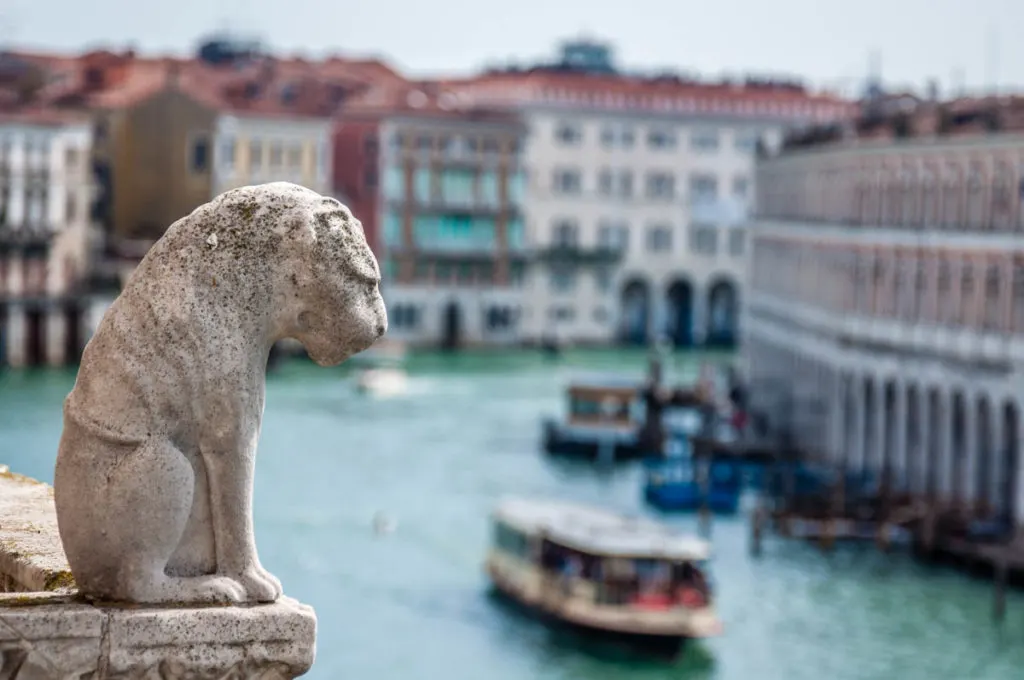Are You Planning a Trip to Venice – Italy’s City of Canals?
Hello! Here you will find my ultimate travel guide for Venice or Venezia as they call it in Italian. Use it to make your travel planning easy, logical, and enjoyable. It will also help you experience the uniquely beautiful City of Canals in the most authentic way.
The information is organised under several topics, for example:
- Is Venice worth a visit?
- How to reach Venice and how to navigate this car-free city?
- What to eat and where to stay in Venice?
- Which major landmarks, museums, and churches are a must-see in Venice?
- What hidden corners to explore in Venice and what day trips to take from the City of Canals?
There are also maps, practical details, and lots of beautiful photos to give you an idea of what to expect. You will also find the best times to visit Venice, packing suggestions, and how long you should stay here. I have included links to the best guidebooks and books for Venice, the best tours you can take here, as well as a list of the artisan Venetian products to shop for.
Right at the end, you will find my top 5 tips for visiting Italy’s splendid City of Canals. This is followed by the five things you should never do in Venice!
It’s all based on my visits to Venice and the Venetian Lagoon over the last twenty years. You can easily scroll up and down to focus just on the type of travel details that you need.
Have a look and enjoy your Venice trip!
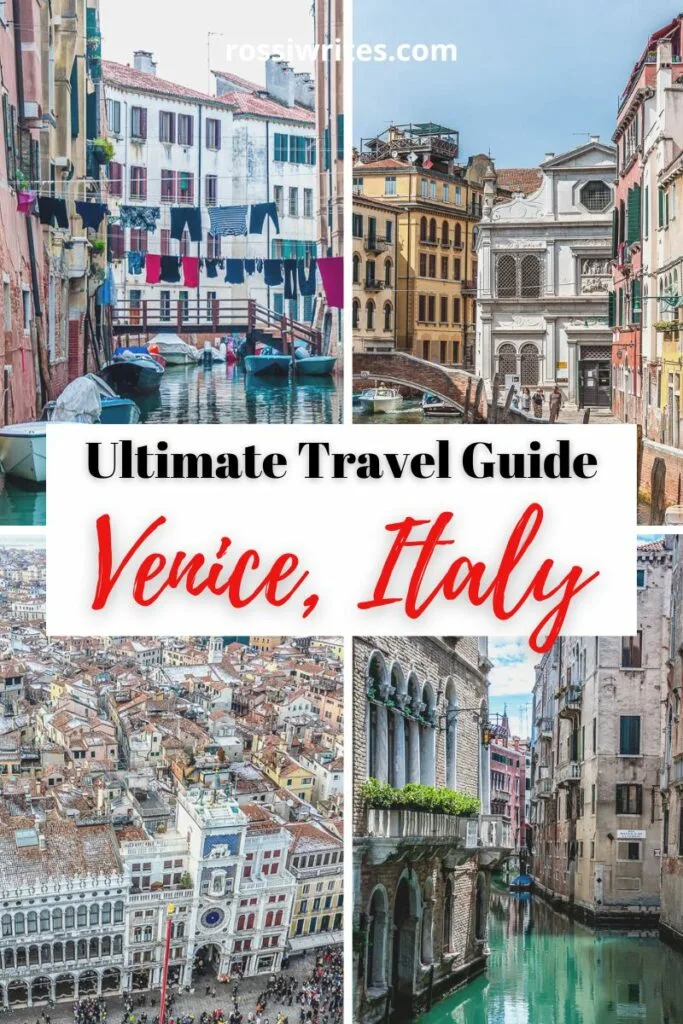
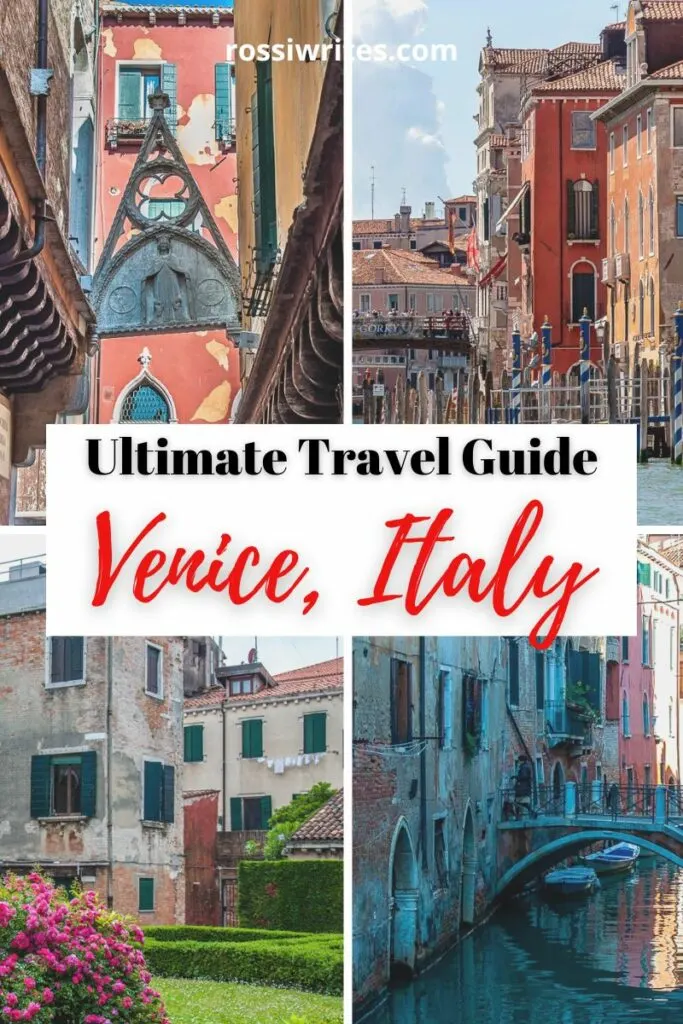
The information in this travel guide reflects my first-hand experience. It may contain affiliate links and if you click and make a purchase through them, I may receive a small commission at no cost to you. The ads on this page help me keep this blog free and produce new travel content for you to enjoy. Full details in my Disclosure.
WHERE IS VENICE?
Venice is a municipality in northeastern Italy and the capital of the northeastern Italian region of Veneto. Famous all over the world, it has a unique urban plan and it’s composed of several different parts. They are:
The historic centre of Venice – built on a cluster of 118 small islands in the Venetian Lagoon and surrounded by water on all sides, this is Venezia proper in terms of history, architecture, and art. For over a thousand years, it was the capital of the historic Republic of Venice. Nowadays, it is one of the biggest tourist destinations in the world. Dozens of major landmarks, must-see museums, and important churches are concentrated here. About 53,000 people live in the historic centre of Venice.
The mainland area of Venice – a collection of mainland towns and boroughs. In general, these are heavily industrialised and don’t offer the attractions of Venice. The most well-known ones are Mestre and Marghera. About 180,000 to 200,000 people live in the mainland area of Venice. Just under 90,000 of them are in Mestre. Mestre has its own historic centre but this is not on par with Venice. It’s a place that offers convenient shopping, cheaper accommodation, and it has the rather striking M9 Museum of the 20th Century.
Other islands in the Venetian Lagoon – several other islands dotted around the Venetian Lagoon are part of the municipality of Venice. Among them are Lido di Venezia, Murano, and Burano.
IS VENICE WORTH A VISIT?
Venice is one of the world’s most beautiful cities. Built on islands in the Venetian Lagoon and with a history that spans over 1,600 years, the City of Canals is one of those destinations that needs to be seen at least once in a lifetime.
There is lots for the discerning traveller to see and do in Venice. From the city’s unique natural setting to its centuries-old churches and famous museums to exciting festivals and spooky corners, Venice is a multilayered city that appeals in equal measures to the senses and the mind.
Book your visit to Venice now for the fantastic views of the Grand Canal, the art-laden Doge’s Palace, the golden mosaics of the Basilica of San Marco, and for the incredible catalogue of paintings kept in numerous galleries. Come to Venice to learn about the Venetian way of life, sample the unique Venetian cuisine, and enjoy a gondola ride. Above all, head to Venice for the opportunity to see how the human mind and will turned an inhospitable, marshy area of the Venetian Lagoon into one of the most splendid civilisations to have ever existed in Europe.

WHAT IS VENICE CALLED IN ITALIAN?

In Italian, Venice is known as Venezia. The city’s name is based on the Indo-European root wen meaning to love, to desire, to strive for. Other words derived from it are to venerate and to win as well as the name of the Roman goddess Venus.
Throughout its existence of 1,600 years, Venice has also accumulated several different monikers. Among them are the Dominant, the Queen of the Adriatic, and the City of Water.
Venice’s historically most well-known moniker is La Serenissima. It dates back to the times when the city was a powerful maritime republic. The title of Most Serene was an acknowledgment of its status as a sovereign state. In this context, the term serene meant supremely dignified, august, and marked by majestic grandeur.
VENICE AND ITS SESTIERI
Venice is divided into six neighbourhoods known in Italian as sestieri (sing. sestiere). They are Cannaregio, Santa Croce, San Polo, Dorsoduro, Castello, and San Marco. Three of them are on the left-hand side of the Grand Canal and three are on the right-hand side.
Historically, most Italian cities used to be divided into four quarters (in Italian, quertiere) or districts. Venice is one of a handful of cities in Italy that were originally split into sestieri. Milan and Genoa are two other such cities here although they have long overgrown their ancient administrative division.
Learn more:
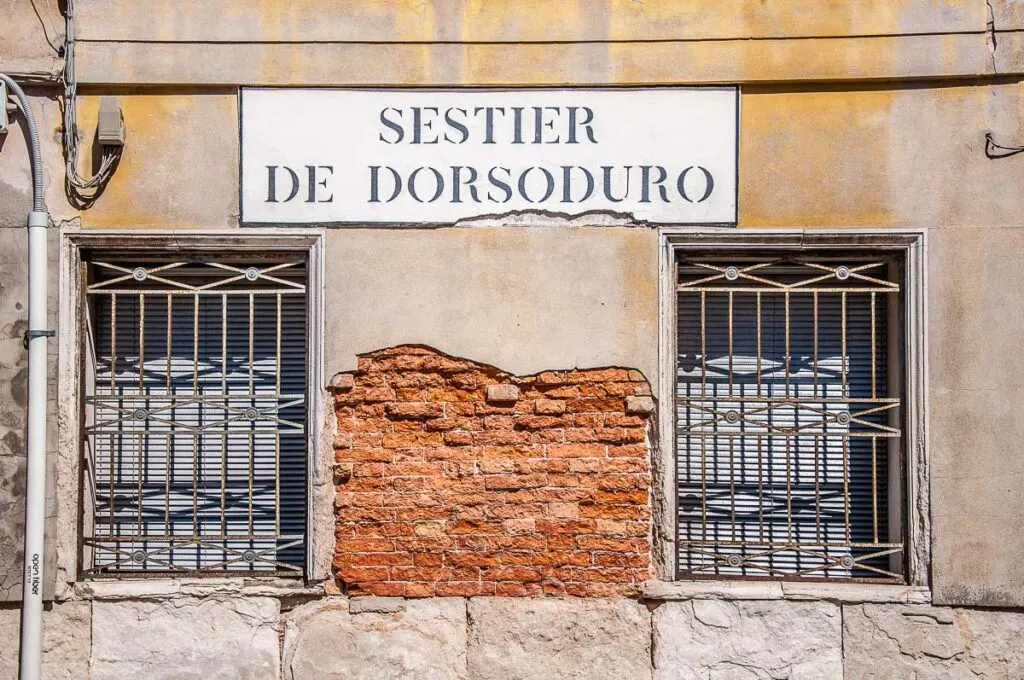
BEST AIRPORTS FOR VENICE
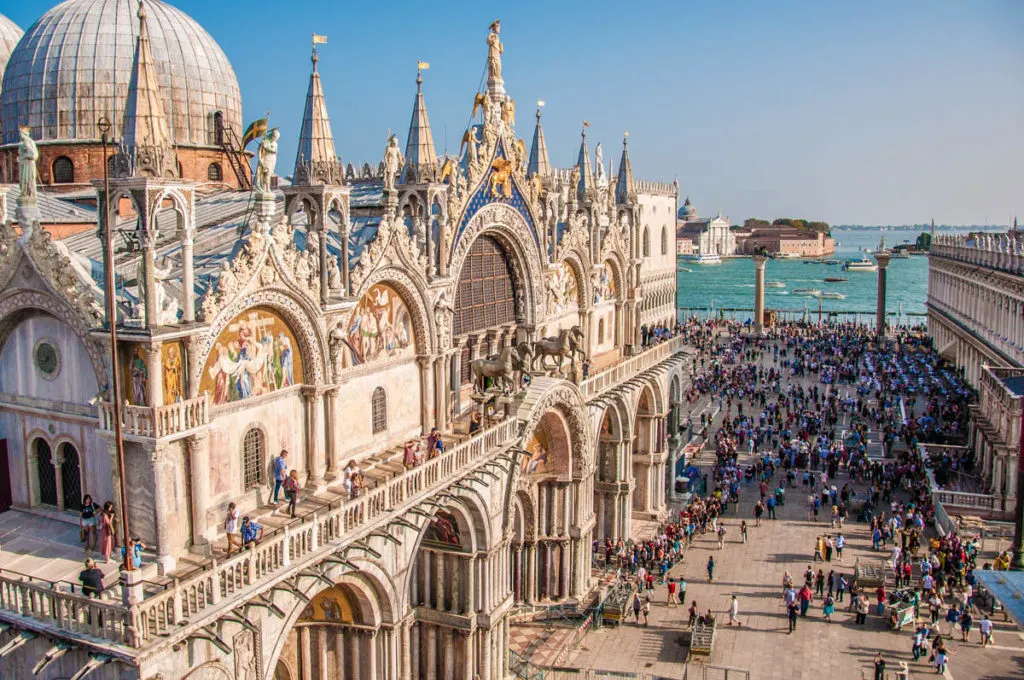
The two most convenient airports for Venezia are Venice Marco Polo Airport and Treviso Airport.
There are three more airports that are within easy distance from the City of Canals and can be a great point of arrival for a Venetian holiday. They are the airports of the northern Italian cities of Verona, Trieste, and Bologna.
For details about how to reach Venice from each of these five airports, have a look at this exhaustive blog post:
HOW TO REACH VENICE?
Venice is very easy to reach by railway, road, and boat from anywhere in Italy and abroad. High-speed and regular trains connect Venice all throughout the day to many small towns and large cities in Veneto as well as major cities in Italy and capitals in Europe.
Have a look at these blog stops for specific travel directions: Verona to Venice, Florence to Venice, Milan to Venice, Bologna to Venice, Treviso to Venice.
A long bridge connects the Venetian mainland to the historic centre of Venice. The bridge has two parts:
Venice Railroad Bridge – completed in 1846, this is the railway track bridge that allows trains to reach the historic centre of Venice across the water. The railway tracks end at Venezia Santa Lucia which is an end-of-the-line train station. For more details about it, see this blog post: Which Venice Train Station is Best – Venezia Santa Lucia or Venezia Mestre. To check train times and book tickets in advance, have a look at Omio, ItaloTreno or TrenItalia.
Liberty Bridge (in Italian, Ponte della Liberta’) – completed in 1933, this is the road bridge that allows cars, buses, and other vehicles to reach Piazzale Roma in Venice and the adjacent island of Tronchetto. Piazzale Roma offers some parking facilities. Tronchetto serves as a large car park. Otherwise, the historic centre of Venice is completely car-free and fully inaccessible to cars.
Alternatively, you may want to park at the Fusina ferry terminal and take a pedestrian ferry from there straight to Fondamenta delle Zattere in Venice. This is a very convenient way to travel, especially if you are staying elsewhere in Veneto, have a car at your disposal, and want to visit Venice on a day trip.
If you want to transfer your car from the mainland to the island of Lido di Venezia (where cars are allowed), then you need to catch a special ferry called traghetto.
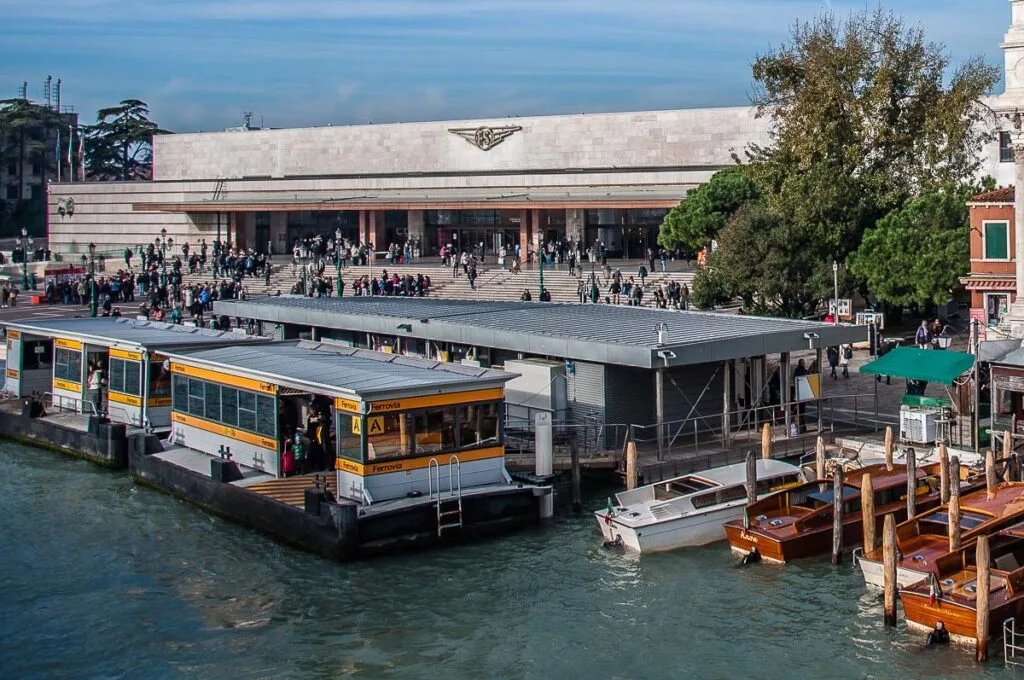
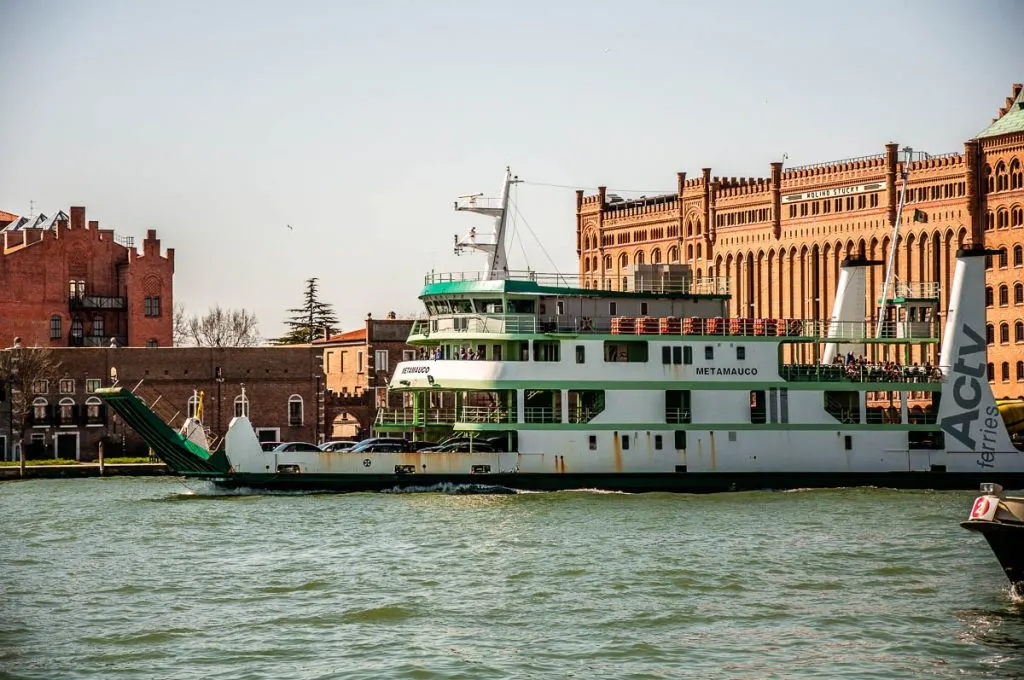
HOW TO NAVIGATE VENICE?
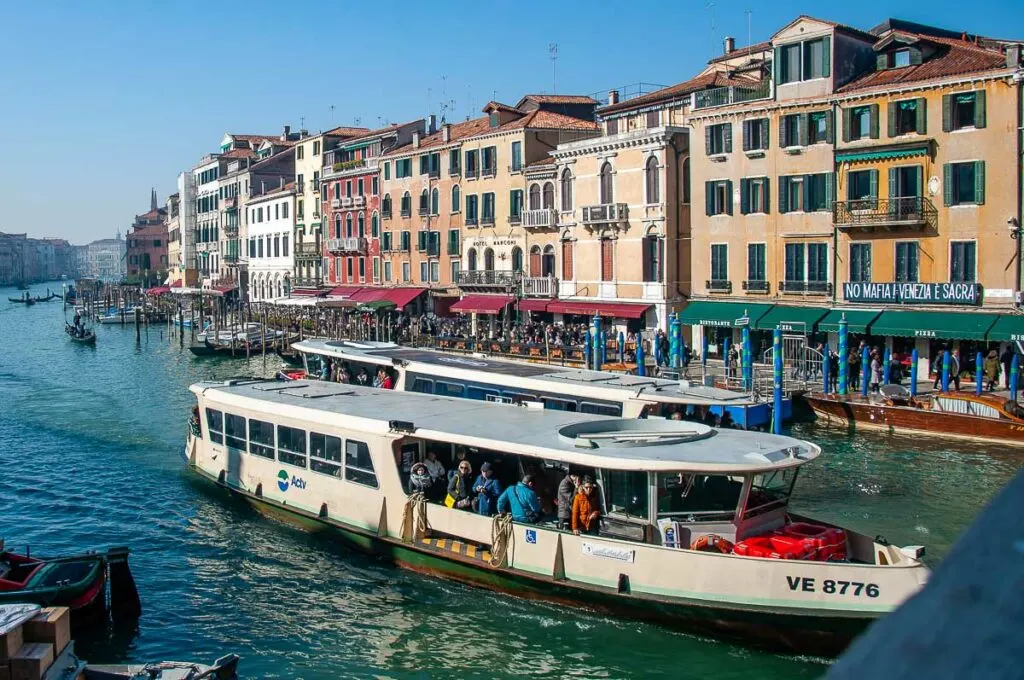
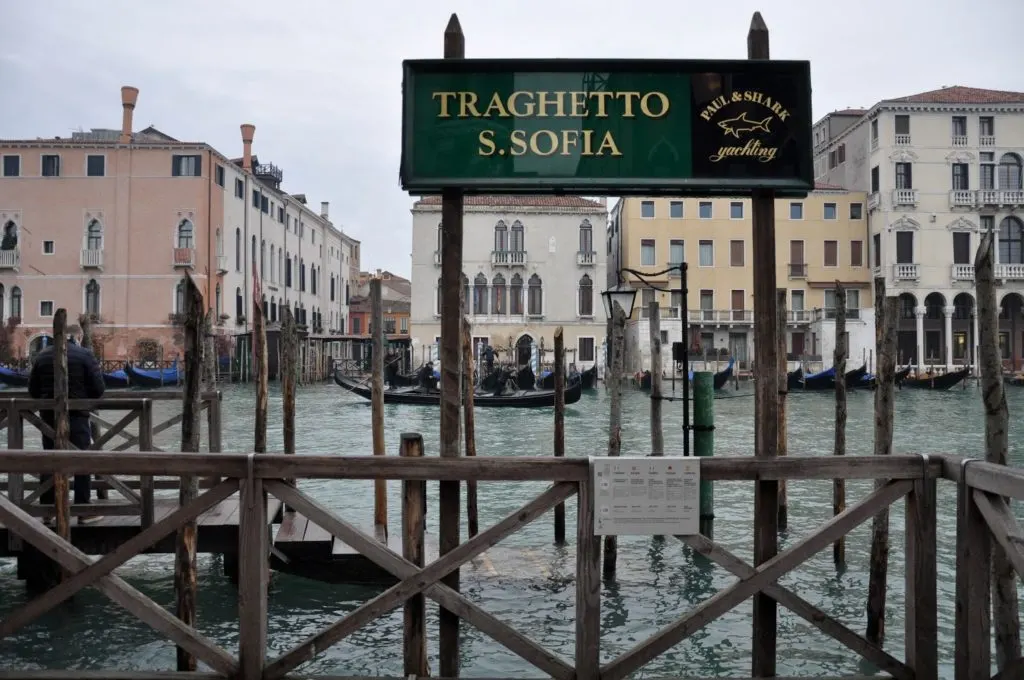
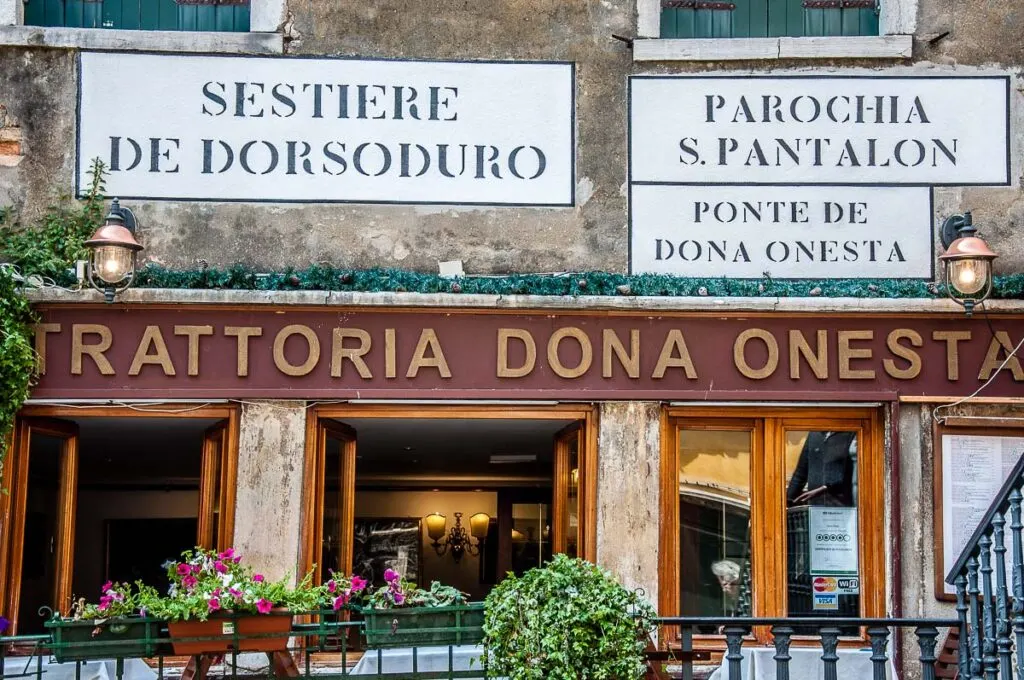
In a nutshell, you have two options to explore Venice. One is by boat and the other one is on foot.
Simply put, there are three types of watercraft you can use here (for info on gondolas, scroll further down):
Vaporetto – Venice’s water buses go up and down the Grand Canal, some smaller canals, around the city, and connect it to nearby islands. You can check the current timetables at this link. When you book your accommodation in Venice or one of the islands in the Venetian Lagoon, ask which is the nearest vaporetto stop. You can also buy a single or a multi-day pass for Venice’s vaporetti from here. Once you get off at the right stop, you will need to walk.
Motoscafo – Venice’s water taxis. They are beautiful and sleek. Quite pricey, too. Yet, if you want to do Venice in style, consider booking a motoscafo. If you travel in a group or as a large family, hiring a motoscafo may be much more convenient and comfortable than lugging suitcases on the vaporetti and then walking long distances with children in tow.
Traghetto on the Grand Canal – black boats that look like an unadorned gondola. They serve to take you across the Grand Canal at spots that are far from the four bridges that cross it. The Grand Canal traghetto is different from the car traghetto which connects the mainland to the island of Lido di Venezia in the lagoon.
Most of the time, however, you will be getting around Venice on foot. The City of Canals is a real-life maze where you will soon come across many unusual place names. For example, calle, fondamenta, parochia, sestiere, sottoportego, and nizioleto.
To learn how to orient yourself like a Venetian, have a look at this blog post:
WHAT TO PACK FOR VENICE?
The most important thing to pack for a visit to Venice in any season is a pair of comfortable shoes. You will be walking long distances over all types of historic surfaces and spending time on your feet over long periods of sightseeing, so make sure that your feet are as comfortable as possible. Choose shoes with a good grip that cushion your feet and support your ankles at all times.
In winter, bring warm layers to stave off the chills produced by the high moisture levels. In summer, bring a hat, sunglasses, and suncream to counteract the bright sunlight that bounces off the stone facades and water canals.
During the high season, make sure that your outfits are appropriate. As such, shoulders and knees should be covered in churches and sights and swimsuits are not acceptable attire on the street.
During acqua alta season (usually from October to March) when the risk of flooding is at all times high, bring waterproof shoes and trousers and make sure that you have enough spare clothes to change into if necessary.
In any case, don’t overpack as navigating Venice with heavy luggage can be difficult, expensive, or both.
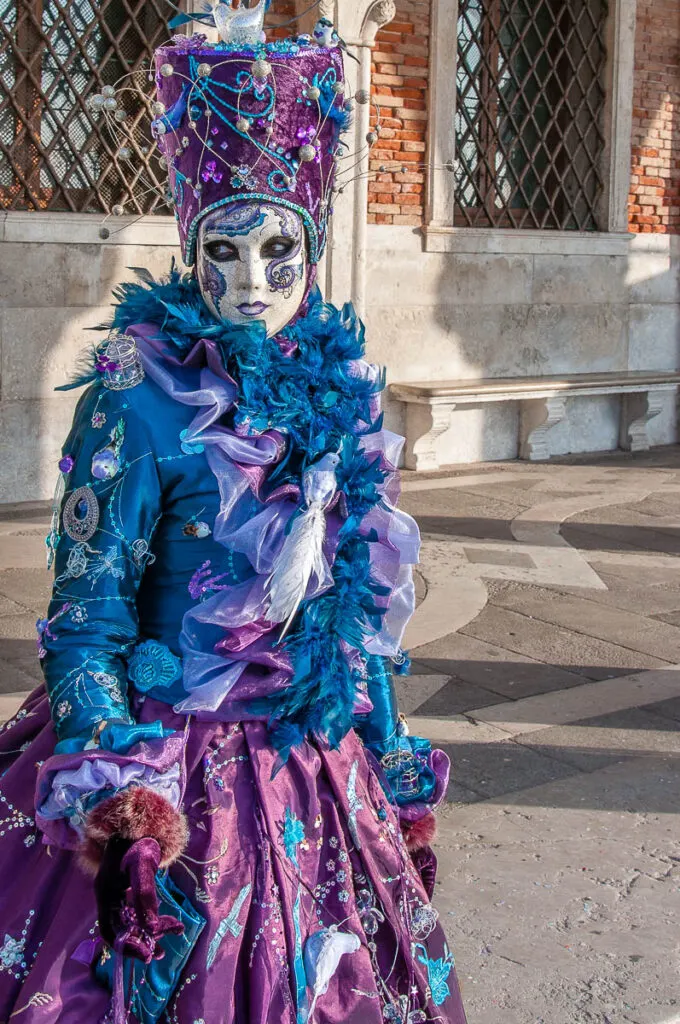
BEST TIME TO VISIT VENICE

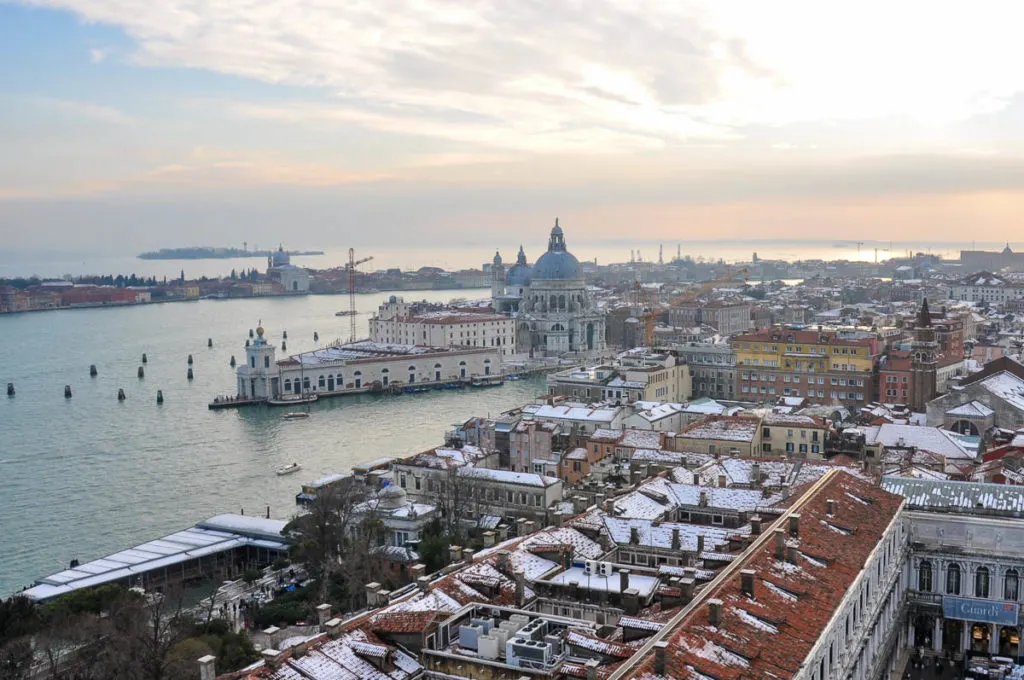
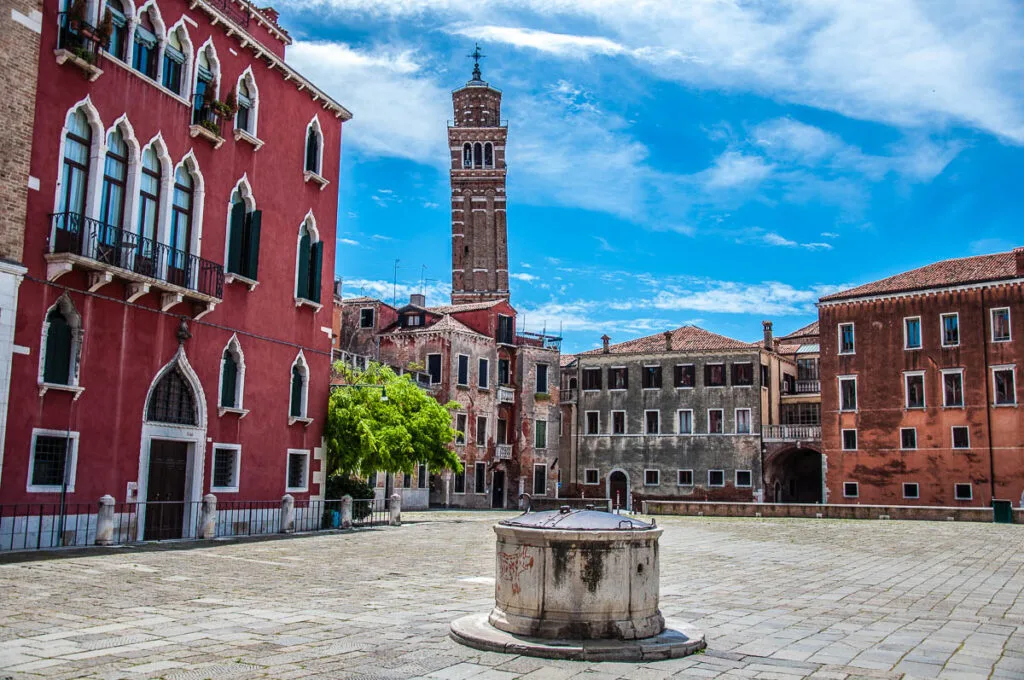
Venice is beautiful in any season and there are lots of things to do here no matter the weather. So, visiting Venice is always a good idea – from a short break to a longer holiday, the City of Canals is a deep dive into the history, art, and heritage of this corner of Italy and Europe.
The low season – between October and March – is my favourite time of the year to head to Venice. This is when it’s very easy to escape the crowds and get to know the truly authentic Venetian corners and stories.
There are three things to keep in mind though:
Acqua alta season brings an elevated risk of flooding and certain areas around the city may be accessible only via the tall wooden platforms that are positioned along flooded streets and squares.
In winter, Venice can get very cold. While snowfalls are very rare here and don’t last long, the humid air is full of chills, so warm layers are a must.
Carnival season – usually between the end of January and February – brings huge crowds to the City of Canals. Expect higher prices for accommodation, bottlenecks, and a constant stream of people.
The high season – April to September – starts with blooming wisterias and ends with Regatta Storica (a historic boat parade followed by a boat race). There are lots of events and festivals to enjoy in Venice during this time. Yet, expect high temperatures – suffocating in July and August – and crowded central parts of the city.
In other words, there is never a truly perfect time to visit Venice. Yet, it’s always a good idea to head there. It’s best not to overthink it, just book the tickets for when you have a few free days next, and enjoy everything that Venice has to offer no matter the weather and the season.
HOW LONG TO STAY IN VENICE?
For a first visit to Venice, ideally, I would suggest four full days:
- two to see the major landmarks here and get your bearings around the City of Canals;
- one for a day trip to one or more of the islands in the Venetian Lagoon;
- and one for a day trip to either Padua, Vicenza, Bassano del Grappa, or even Verona.
This will give you a good introduction to everything that Venice has to offer and will whet your appetite for more specific things to do and see here.
Any return visits can be of any length and focused on particular topics – art, history, hidden gems, and so on.
In any case, if you don’t have four days to spare and yet you really want to see Venice, just come.
My first visit was a day trip from London! That was all I could afford at the time and I was desperate to experience the City of Canals. Since then, I have returned many times for a varying number of days, and each time I fell deeper in love with this unique, multilayered city.
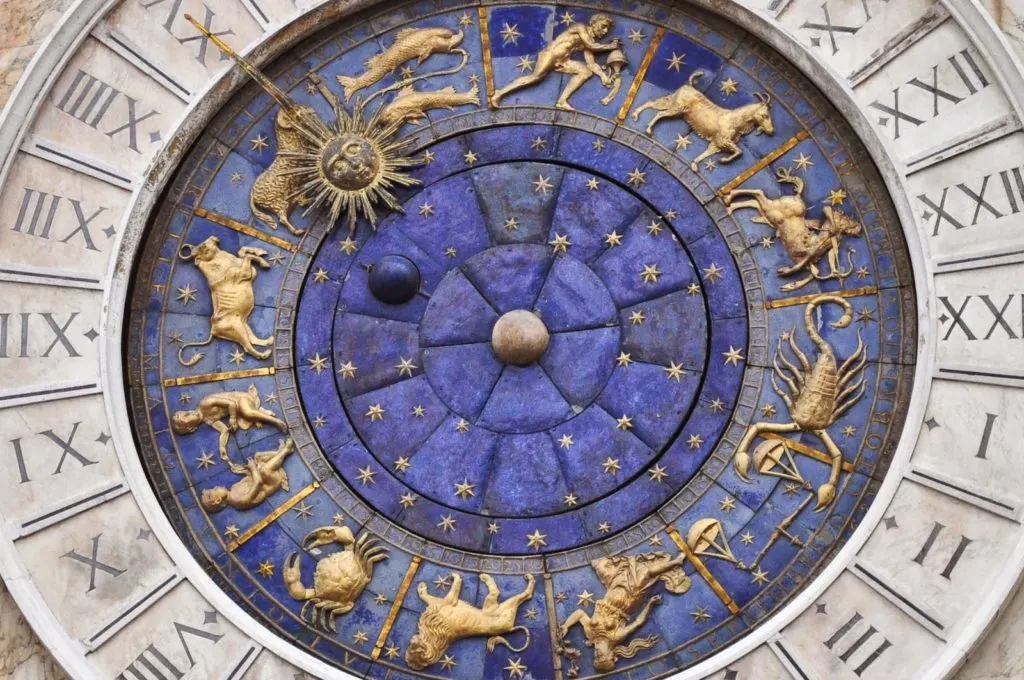
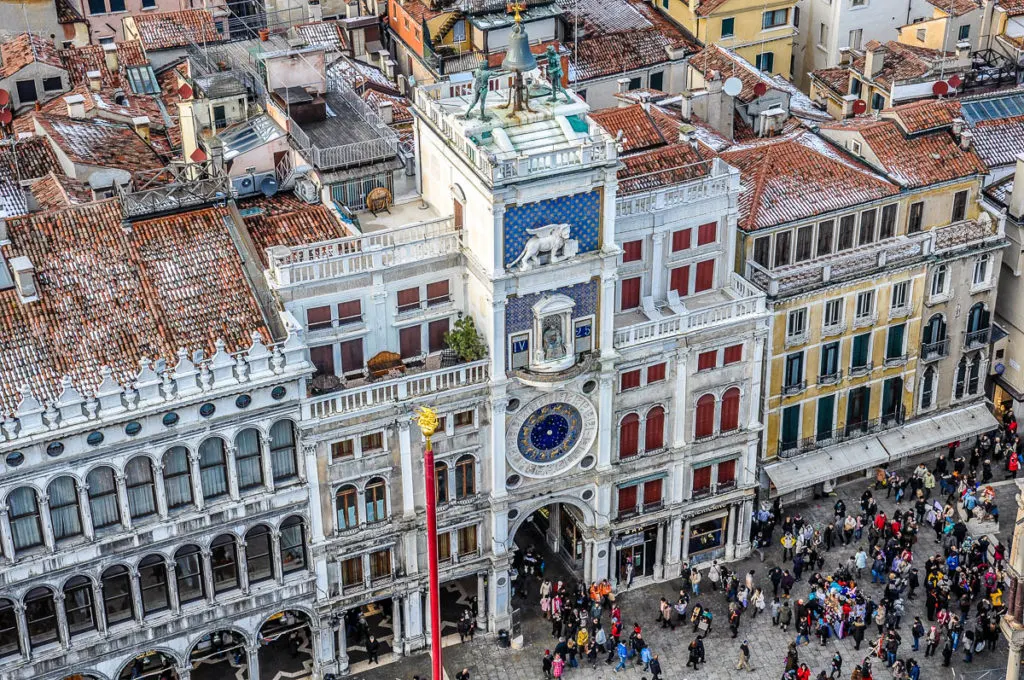
WHERE TO STAY IN VENICE?
There is a huge selection of places to stay in Venice in any season.
You can choose a historic palazzo that nowadays functions as a luxury hotel. You can opt for a cosy B&B with city views. Or you may prefer an accommodation with its own kitchen to enjoy a home-from-home experience.
When picking accommodation in Venice consider carefully its location. Depending on what you want to do and see here, you may prefer to stay closer to the major landmarks, a vaporetto stop, or in a hidden corner that offers peace and quiet.
Some people even choose to stay in Mestre on the Venetian mainland on account of supposedly cheaper prices. Mestre, however, doesn’t have Venice’s history and charm. Having to rely on public transport each day just to reach Venice and then explore on foot, gets tiring very quickly.
If your focus is sightseeing in Venice, then it really pays to stay in the historic city. Early mornings and late afternoons here are truly precious. You have Venice to yourself and can really experience its authentic spirit.
Here are some suggestions for places to stay in Venice. All come highly recommended:
Luxury: Hotel Ai Reali – Small Luxury Hotels of the World, Ca’ di Dio – Small Luxury Hotel
Mid-Range: Hotel L’Orologio – WTB Hotels, Hotel Saturnia & International, Casa dei Pittori Venice Apartments
Budget: Pensione Guerrato, Casa Accademia
Alternatively, use this map to get a quick visual idea of the available accommodation options in Venice, Italy. You can zoom in and out, type in your specific travel dates, and then click on the different price points for detailed information about the hotel you want to know more about.
In addition, have a look at this blog post which explains the different types of accommodation you can book in Italy. It will give you plenty of ideas to look into for the best and quirkiest places to experience here:
WHAT TO EAT IN VENICE?
Venice has its own unique cuisine. Its development was stimulated by the bounty of fresh seafood provided by the Venetian Lagoon as well as by the historical trade connections that the Republic of Venice maintained with far-flung places across the West and the East.
So, come to Venice with an open mind and ready to experience dishes that may not quite correspond to what the world perceives to be strictly Italian food.
Here are some of the best Venetian foods to sample during your Venetian holiday:
- fritto misto – a mix of seafood and julienned vegetables that have been battered with durum wheat semolina and cornmeal. Then they are served deep-fried on a bed of polenta.
- baccala’ mantecato – the most iconic dish of Venetian cuisine. It’s prepared with stockfish from Norway’s Lofoten Islands and has been a Venetian staple since the 15th century.
- cicchetti (also spelled cicheti) – traditional Venetian finger foods. Served in small portions, there are many varieties of cicchetti, and they can cost as little as a euro or two per piece. This can be a small slice of white polenta with a helping of baccala’ mantecato or a piece of crusty bread with one of many delicious toppings.
- local fruit and vegetables – there are many orchards, vegetable patches, and even vineyards in the Venetian Lagoon. Try the locally grown purple artichokes when in season!
- gianduiotto con panna – a thick slab of frozen chocolate dessert with pieces of hazelnuts studded in it. It’s topped with delicious whipped cream. It’s traditionally sold by Gelateria Nico on the Fondamenta delle Zattere.
- frittelle – these fried dough balls are traditionally sold during the Carnival season. They are either plain and studded with pinenuts and raisins or stuffed with one of several delicious fillings – creme chantilly, crema pasticcera (similar to custard), chocolate, or pistachio spread.
For a quick introduction to Venetian seafood, join a specialised guided tour. This food experience will take you from Rialto Fish Market to two of Venice’s top eateries so that you can wine and dine on traditional Venetian drinks and dishes. This one offers you a five-course Italian seafood feast cooked by a Venetian sailor.
Venice is famous for its pastries, biscuits, and chocolates. Learn about their history and indulge your sweet tooth by joining this guided tour. It will introduce you to a Venetian master chocolatier and their exquisite truffles, pralines, and hot chocolate. This tour will take you on a morning walk of Venice so that you can enjoy the city’s main sights while tucking in a number of traditional local pastries and sweets.
And this kid-friendly tour will open the world of Venetian sweets and desserts in front of your eyes by taking you to authentic local bakeries and patisseries across all six Venetian sestieri and revealing to you the stories of Venice’s most famous sugary delights.
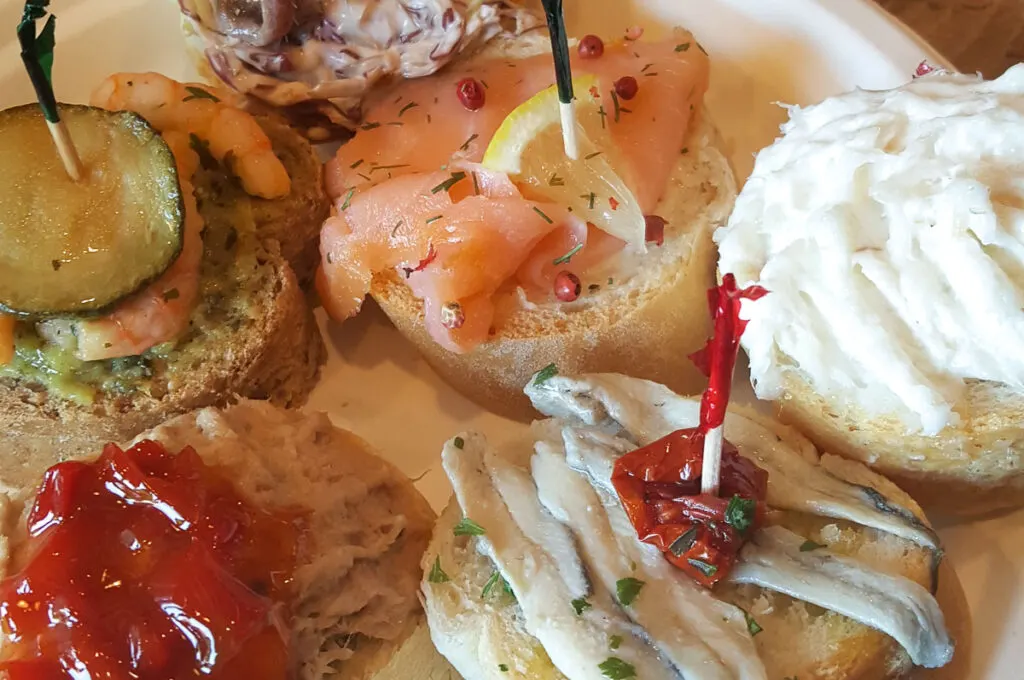
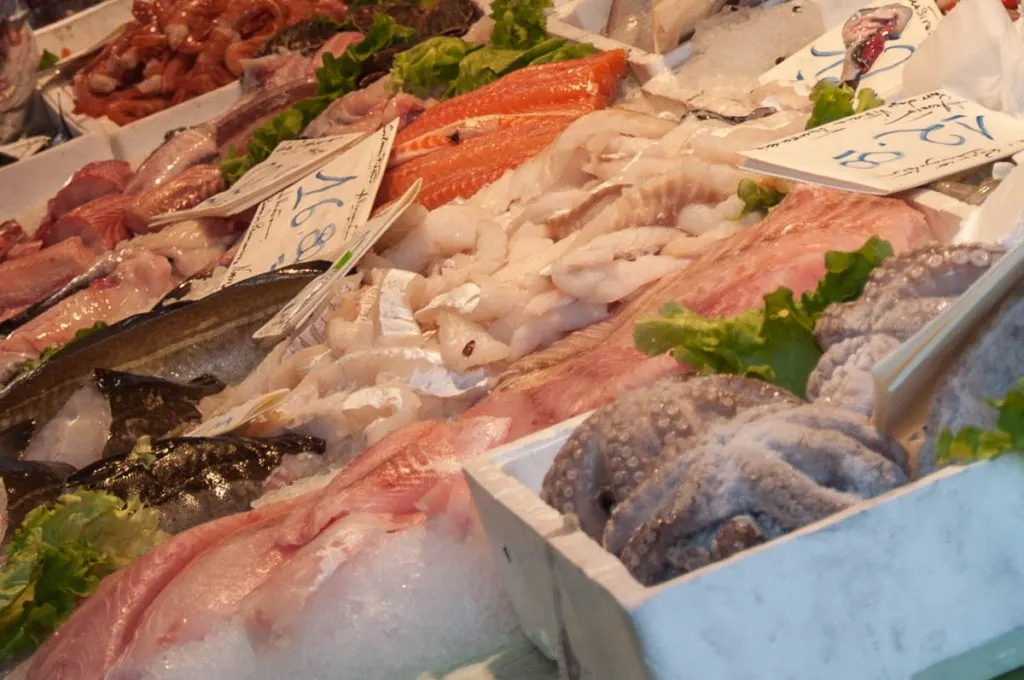
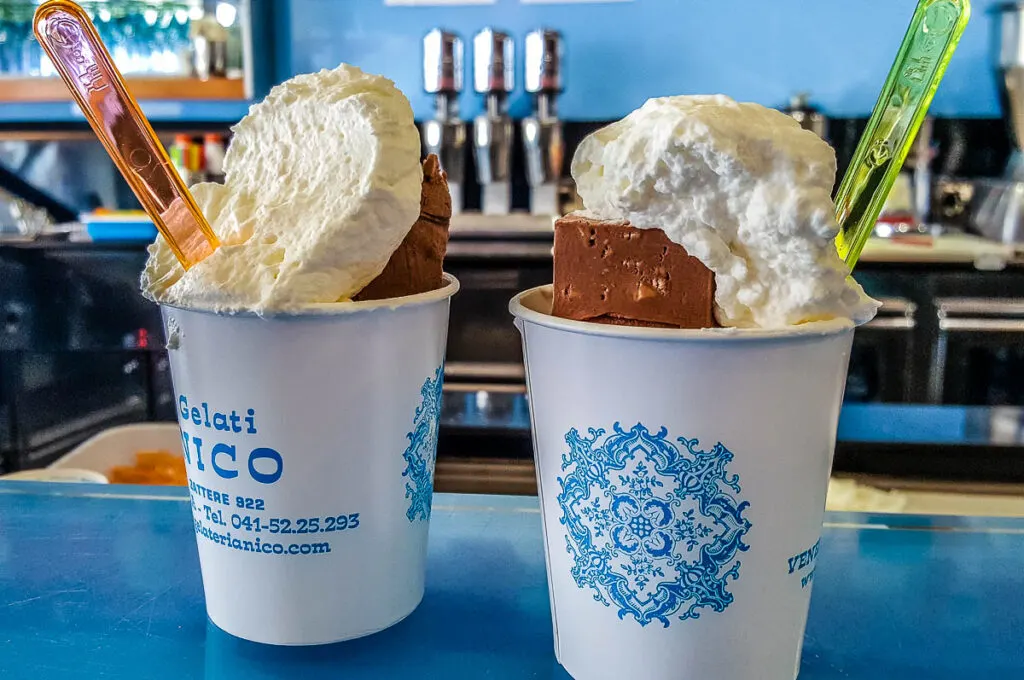
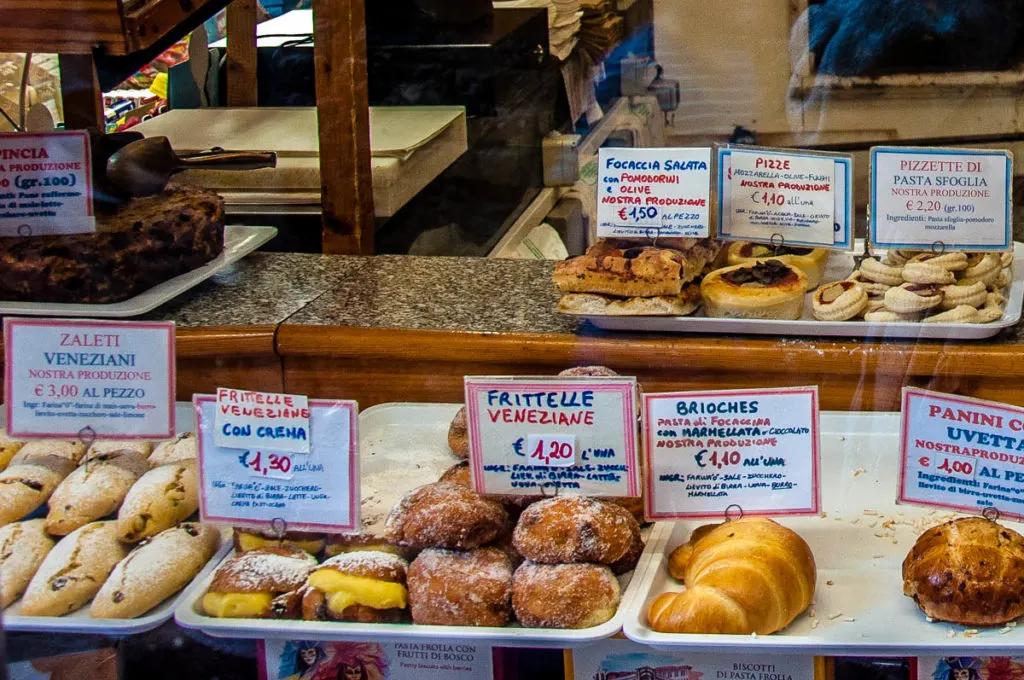
THINGS TO DO IN VENICE
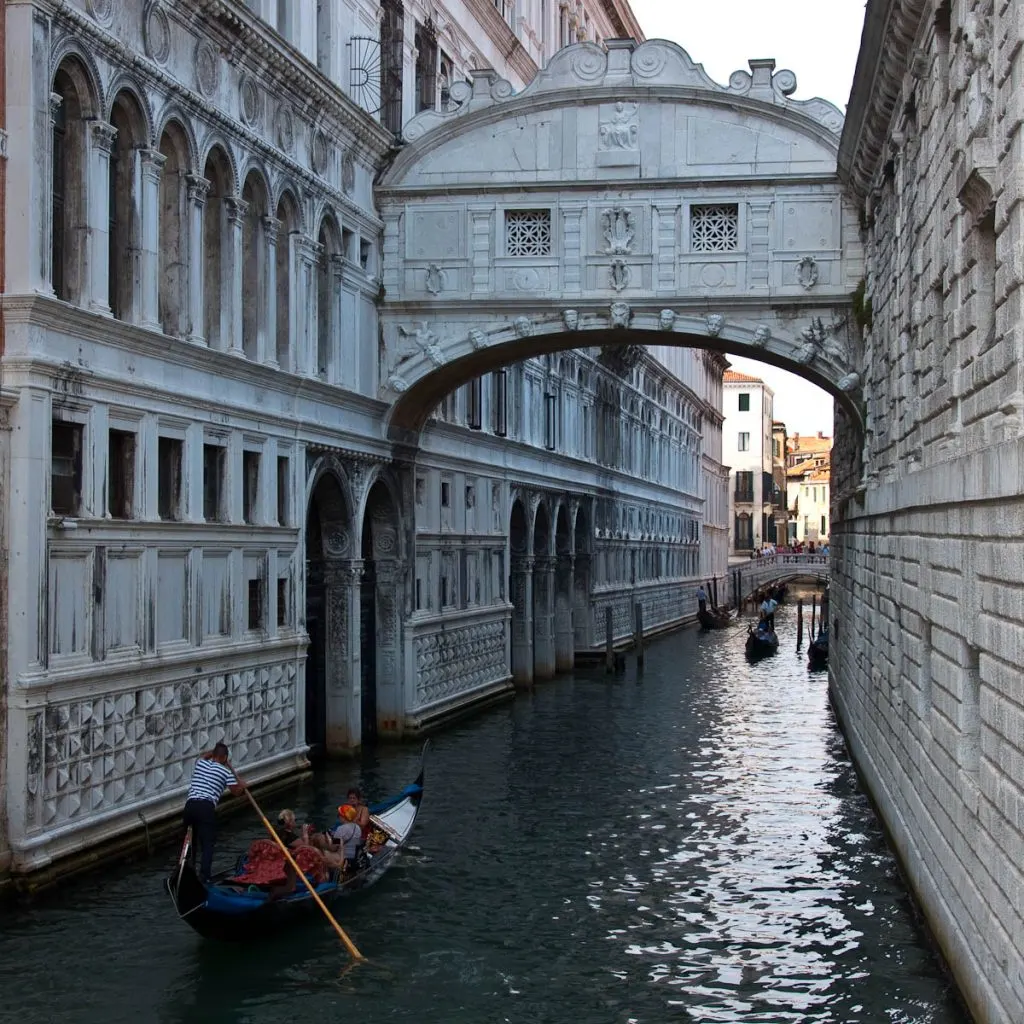
There are many wonderful and exciting things to do in Venice to suit all types of interests and travellers. This beautiful city has a lot to offer to the history buff, the art lover, the architecture aficionado, the photographer, as well as simply to the person who wants to experience something extraordinary.
For a detailed list of all the best things to do in Venice, have a look at this blog post:
It will give you lots of great ideas on how to fill up your time in the City of Canals with great sightseeing and memorable explorations.
MAJOR LANDMARKS IN VENICE
From the Doge’s Palace and the Basilica of San Marco to Rialto Bridge and Gallerie dell’Accademia, Venice is dotted with many worldwide famous landmarks. Visiting them, one by one, will enrich your visit to the City of Canals and will help you better understand its culture and appreciate its heritage more deeply.
Use this blog post to find out the major sights to see in Venice. It will give you a historic overview of each one of them and what makes it a must-see during your stay:
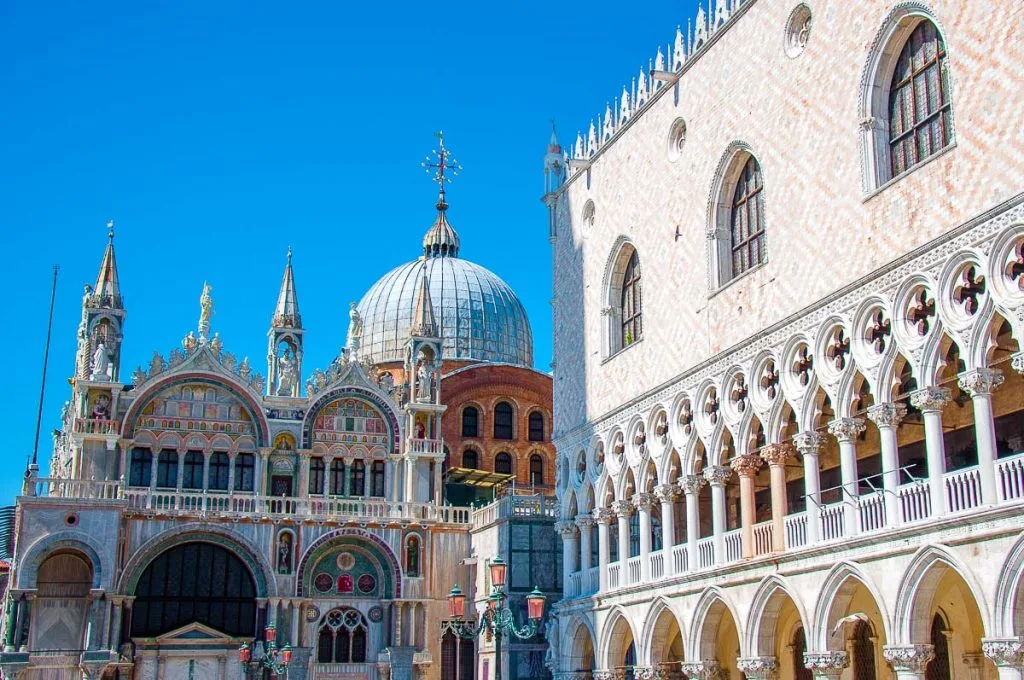
BEST MUSEUMS IN VENICE
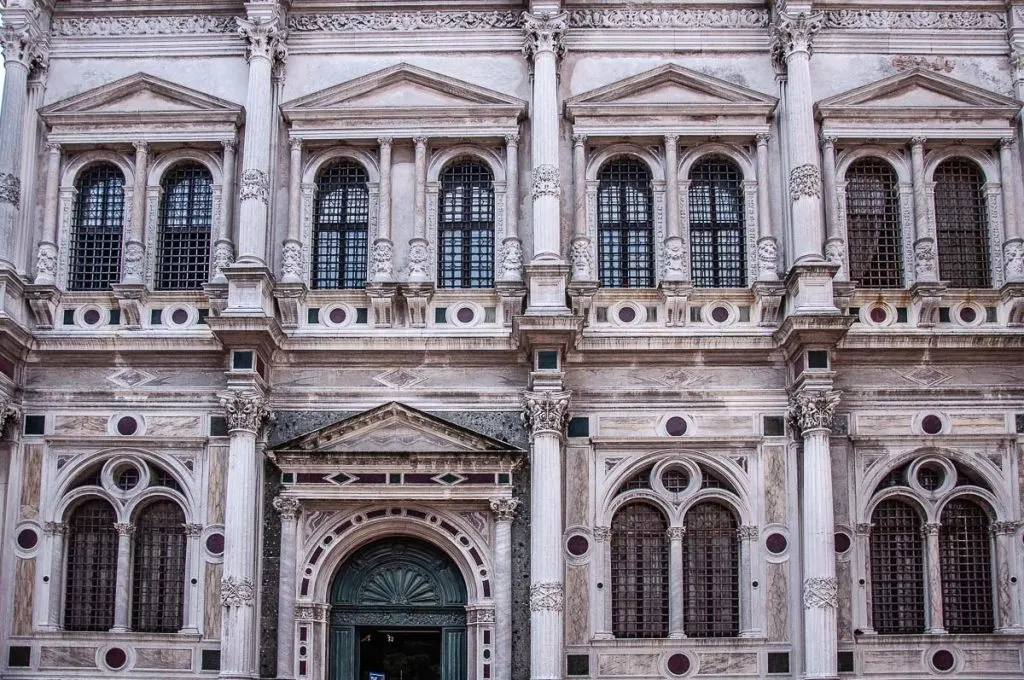
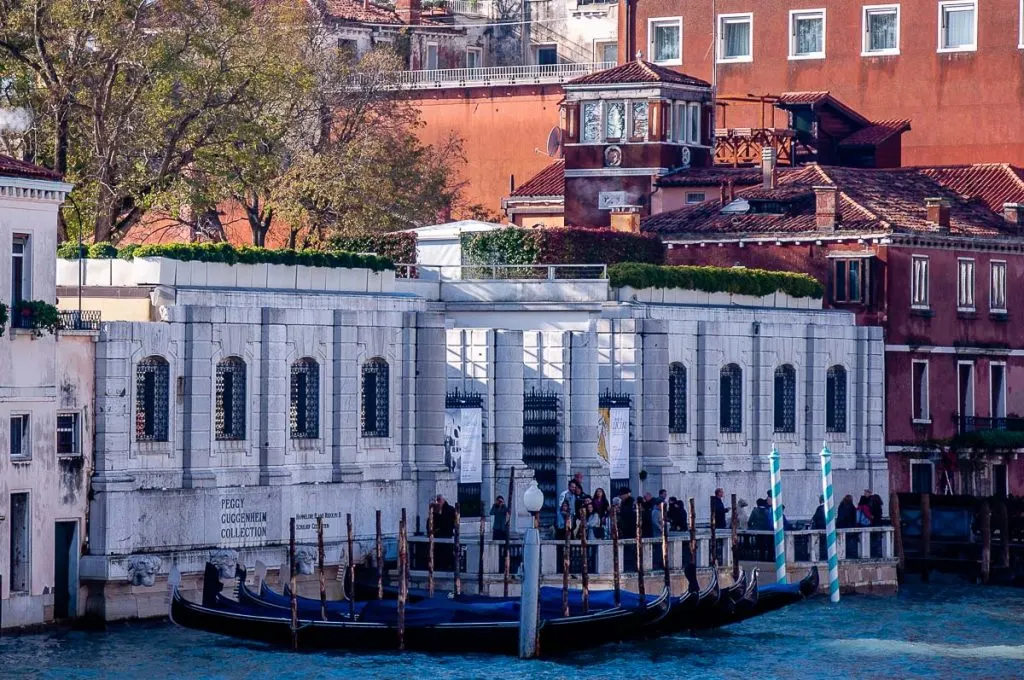
There are many exciting museums dotted all over Venice. Here are five of the best among them:
- Museo Correr – just across St. Mark’s Square from St. Mark’s Basilica, this is a must-see museum in Venice. It explores the history and art of the City of Canals through a series of lavishly decorated rooms. Combine it with a visit to the adjacent National Archaeological Museum and the Monumental Rooms of the National Marciana Library. The combined ticket for all three also includes a fast-track visit to the Doge’s Palace.
- Scuola Grande di San Rocco – the meeting quarters of a 15th-century Venetian lay confraternity house an incredible pictorial cycle by Tintoretto, as well as a rich collection of relics and works of art. Beautiful both in and out!
- Peggy Guggenheim Collection – one of the world’s most important museums of 20th-century European and American art. Peggy’s spirit is still very much palpable around the building. The art workshops for kids held every Sunday are fab!
- Naval Historical Museum – a must-see in order to understand how a small cluster of islands in a marshy lagoon became the foremost maritime power of the Adriatic and the Mediterranean between the 9th and the 18th centuries.
- Ca’ Pesaro Museum – two museums under the roof of a splendid Baroque palace. Expect a beautiful collection of modern art with masterpieces by Rodin and Kandinsky. On the upper floor explore an extensive collection of Japanese, Chinese, and Indonesian artifacts. A great place to visit not least for the lovely Grand Canal views from the palace’s ground-floor cafe.
BEST CHURCHES IN VENICE
Churches in Venice are so much more than a place of religious worship. They are also architectural masterpieces and guard rich repositories of art. These five need to be top of your sightseeing list:
- Basilica of San Marco – expect splendid gold mosaics, important Christian relics, and magnificent Byzantine-inspired architecture.
- Basilica dei Santi Giovanni e Paolo – the largest church in Venice keeps the tombs of 27 Venetian doges and a tremendous amount of art. Right next to it, you can see the famous equestrian monument of the military commander Bartolomeo Colleoni which was designed by Andrea del Verocchio – the teacher of Leonardo da Vinci.
- Basilica dei Frari – this imposing church of red bricks keeps an impressive collection of art and the grandiose tombs of many famous Venetians (with the artist Titian and the sculptor Canova among them). The basilica’s wooden choir stalls are astonishing in their detail. They are adorned with complex scenes in intarsia – a technique used to create images with different species of wood in various shades.
- Basilica della Salute – this Baroque church features in many iconic photos of Venice. It stands right at the spot where the Grand Canal flows into St. Mark’s Basin. The church plays a central role in one of Venice’s most authentic celebrations – Festa della Salute – which takes place on 21st November each year.
- Church of San Pantalon – come here to admire The Martyrdom and Apotheosis of St. Pantalon. Painted over 20 years by Gian Antonio Fumiani, this is, allegedly, the world’s largest painting on canvas. It covers the church’s whole ceiling and has a wonderful 3D effect with figures and objects seemingly emerging from the flat canvas.
Yet, they say that there are more than 200 churches in Venice. So, don’t limit yourself just to the five above. Make an effort to enter every church that comes across your way as you explore the City of Canals. You never know what priceless works of art and little-known Venetian stories you will come across.
Many of the Venetian churches are completely free to visit. Some charge a small entrance fee. With a Chorus Pass, you can see 15 of the best churches in Venice and their rich collections of art for a very reasonable single price.
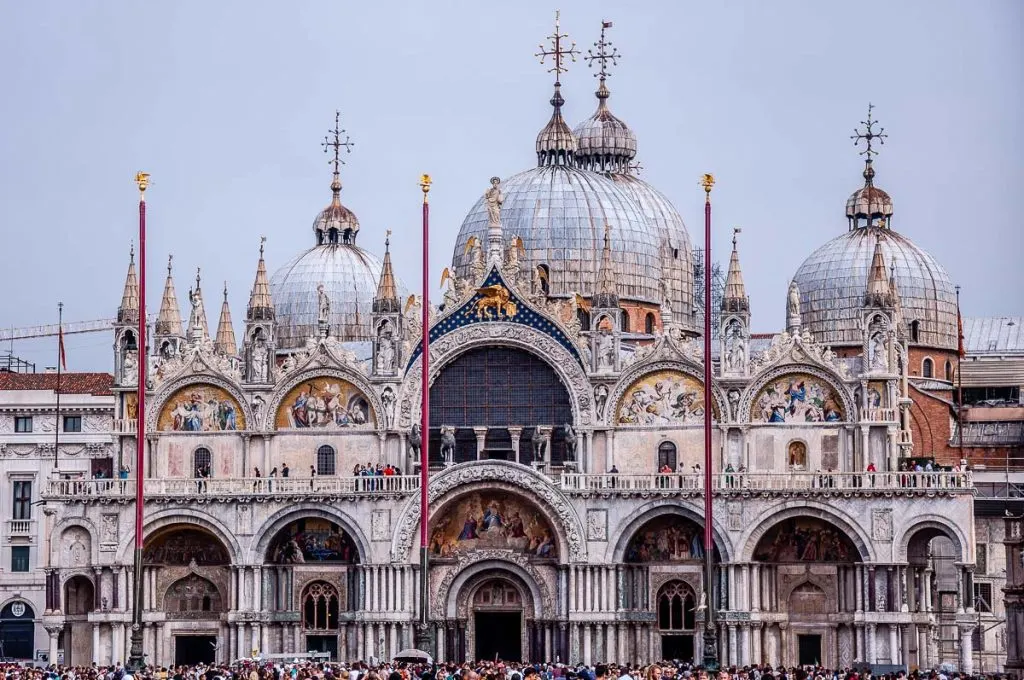
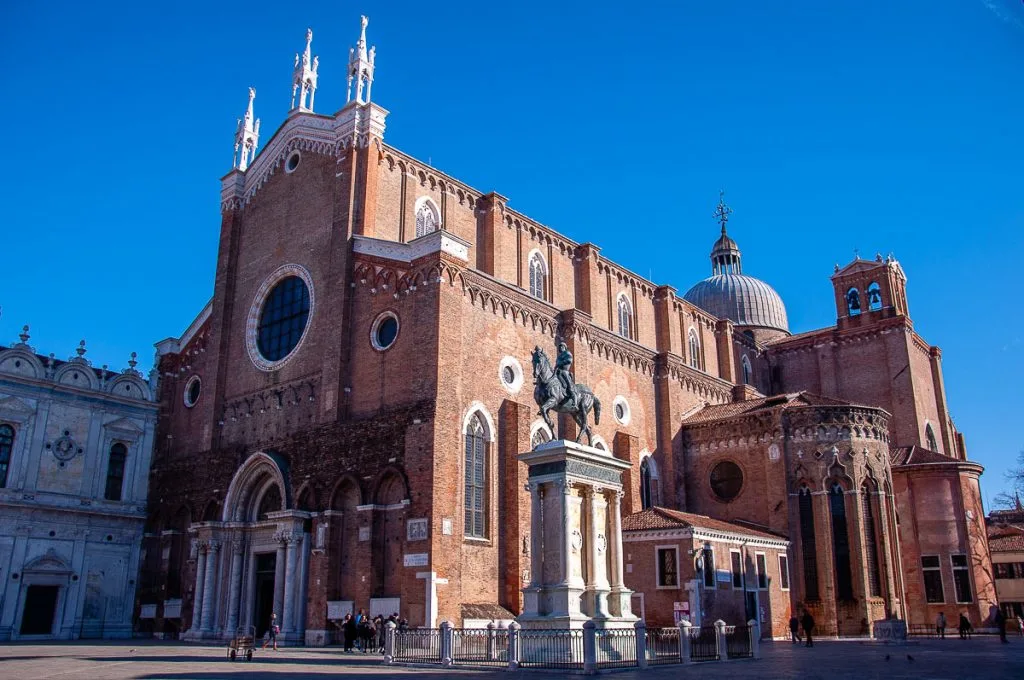
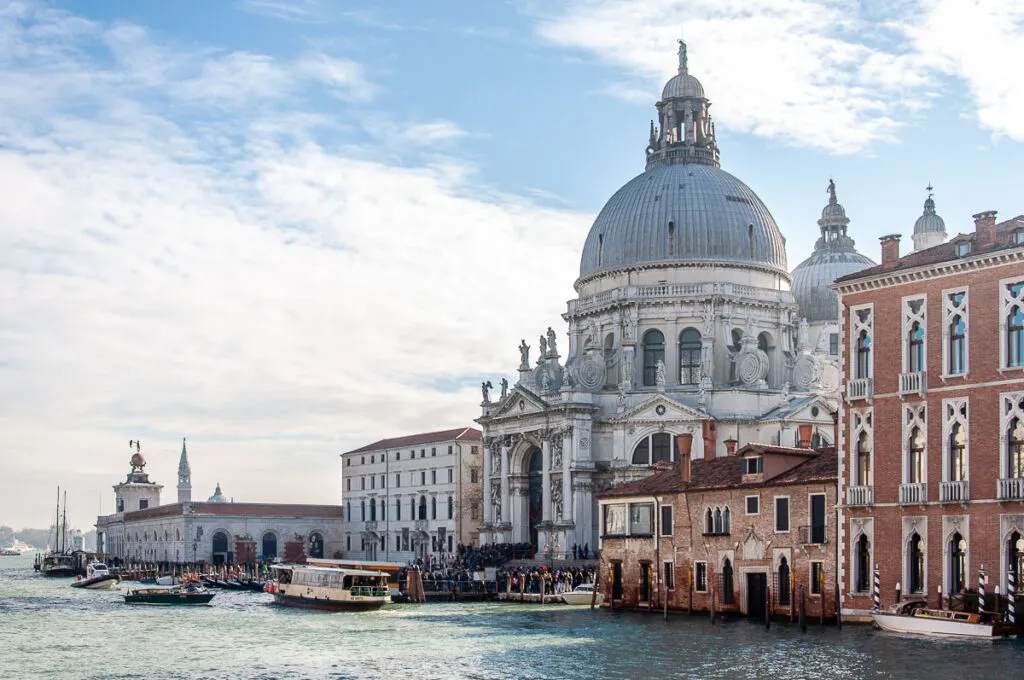
HIDDEN GEMS IN VENICE
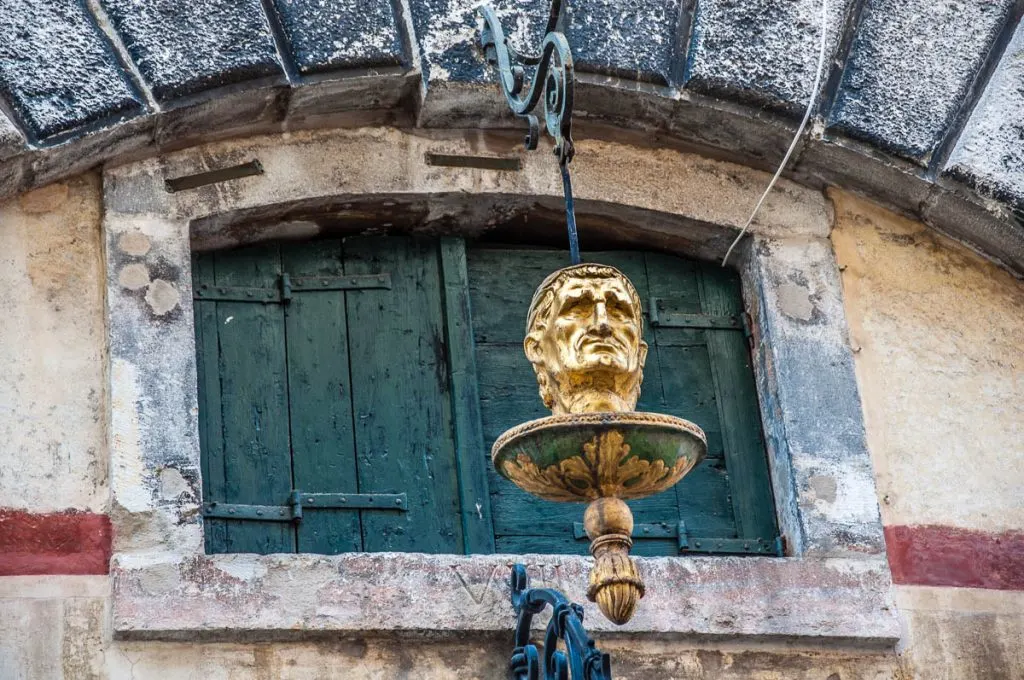
From a bridge with no railings and a bridge where bare-knuckle fights used to take place to lion’s mouths, a hunchback figure, and a one-hand clock, Venice is rich in secret corners and hidden gems. Not to mention the golden head that hangs over the crowds heading to the famous Rialto Bridge! But how many people actually see it?!
Half of the fun of being in Venice is looking for and discovering the unique, quirky things that make it the most exciting place on earth. Use this blog post to guide your explorations:
GONDOLAS IN VENICE
A gondola ride is one of the most iconic things to do in Venice. The gondola is an elegant boat made of eight different types of wood. It’s lacquered in mirror-shine black and it’s rowed by a single oarsman – the gondolier – who stands upright on the stern.
He is dressed in a uniform of a striped top and straw hat, has undergone strict training over several years, and most often than not his father and forefathers have also been gondoliers. Rowing a gondola is one of the oldest trades in the City of Canals.
A gondolier knows where to find all the best waterside views and hidden spots in Venice. Customarily, a gondola ride lasts around 30 mins and the prices to hire a gondola are set up by the city council – Comune di Venezia. Click here to check them on the official website. Further down on the same web page, you will find a list of the official gondola stations with email addresses and telephone numbers to contact them and book a gondola tour in advance.
In addition, you can check these Venice gondola tours to see which one will appeal to you. Many of them combine a gondola ride with another must-have experience in Venice to help you maximise your sightseeing time:
- Grand Canal by Gondola with Commentary
- Shared Gondola Ride across the Grand Canal
- Venice Walking Tour and Gondola Ride
- Private Gondola Ride and Photo Session in Venice
- Best of Venice: Doge’s Palace and Gondola Tour
- Gondola Ride with Commentary
Another way to get close to Venice’s gondola traditions is to visit a squero – a gondola-making workshop. There are only a few of them left in the City of Canals. You can contact either Squero di San Trovaso or Squero Tramontin in advance to book a tour.
Alternatively, you can see the gondola-makers of Squero di San Trovaso at work. For this, head to Rio di San Trovaso – a small canal in the sestiere of Dorsoduro. Walk down to the small eaterie Osteria Al Squero and you will have a full view of the gondolas being repaired and made.
For the full Venetian experience, buy a glass of Prosecco and a selection of cichetti – traditional for Venice finger foods – from the osteria and just enjoy the view.
Another option is to visit the artisans who make the gondola’s most iconic parts:
Fórcola – the typical Venetian rowlock that the gondolier uses as a support for their oar. Each fórcola is tailor-made to match the gondolier’s height and posture. Book a visit to Forcolaio Matto to meet the youngest forcolaio in Venice and see him at work.
Cavallucci marini – these elegant metal seahorses traditionally adorn the Venetian gondolas. They are made by the Antica Fonderia Valese – the last remaining foundry in the City of Canals.
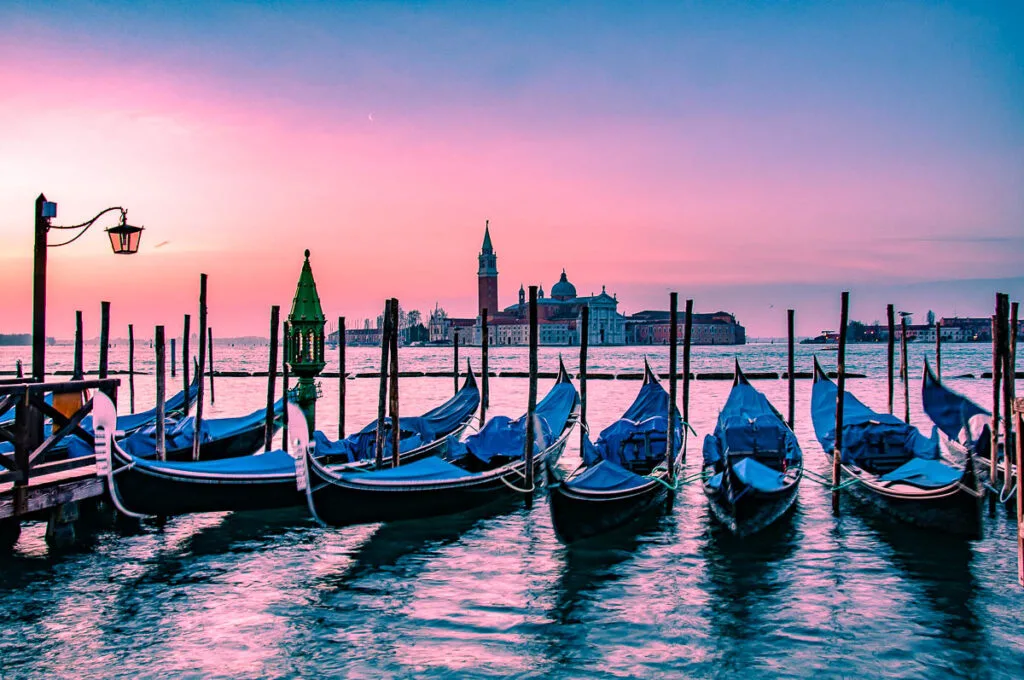
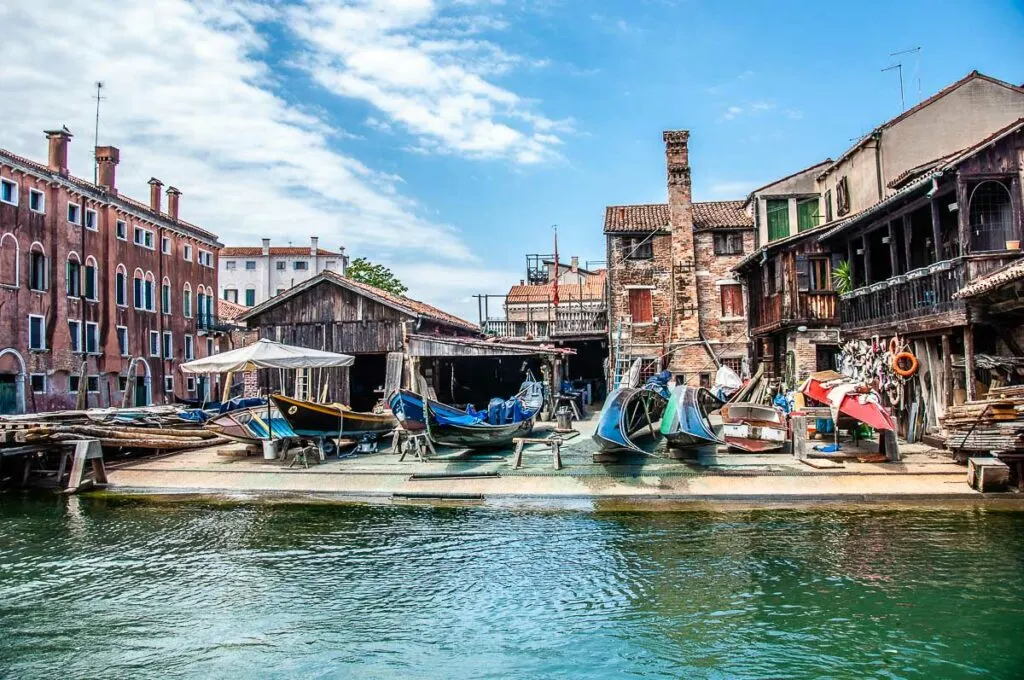
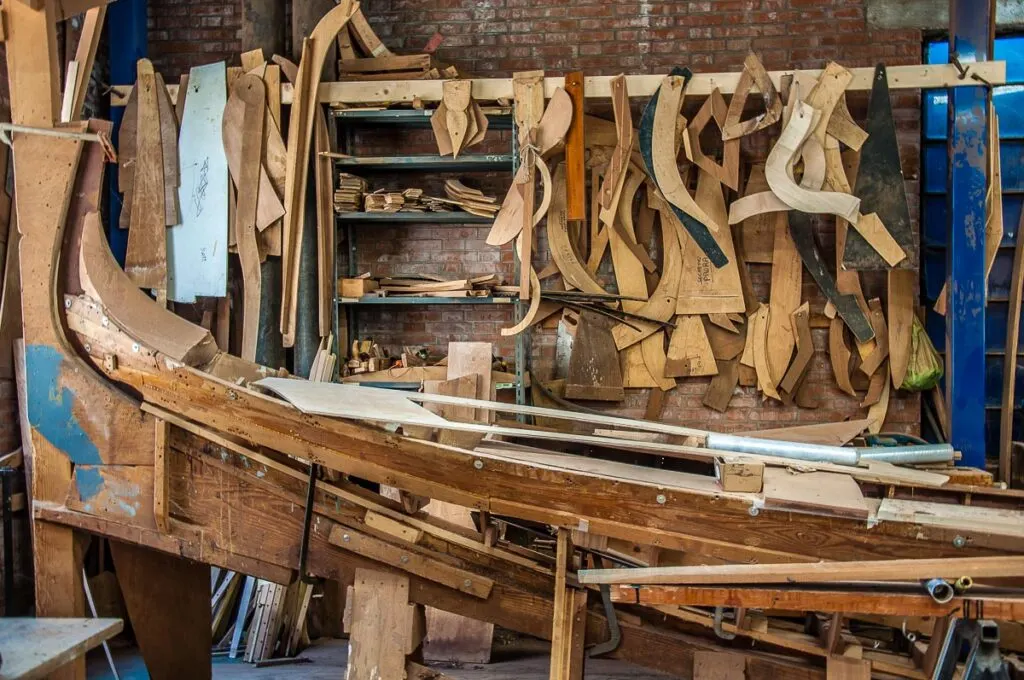
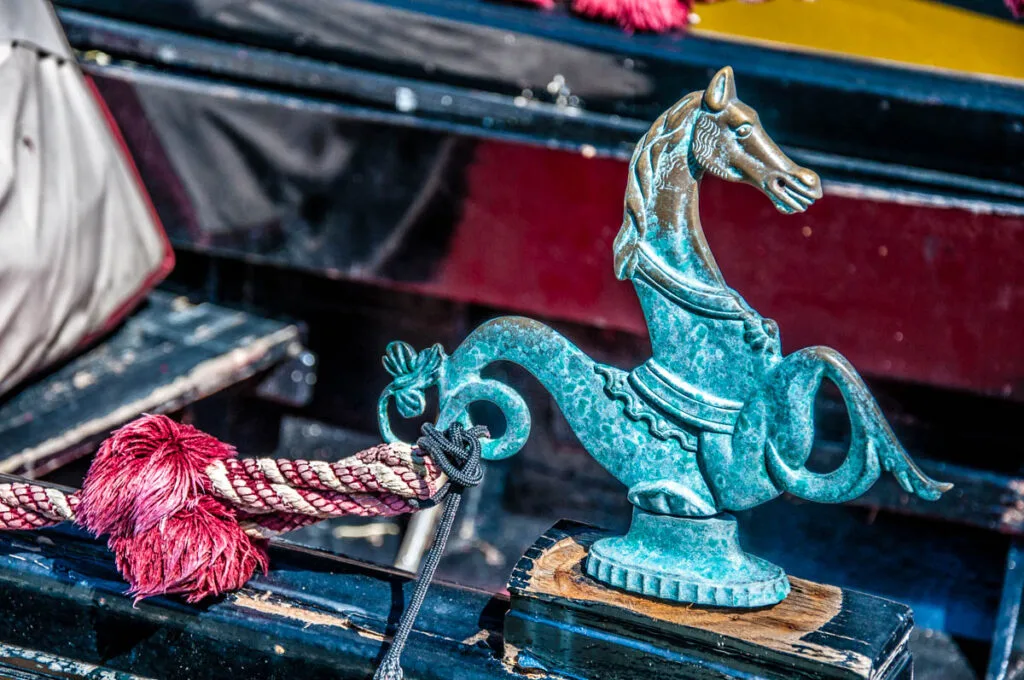
SPOOKY VENICE
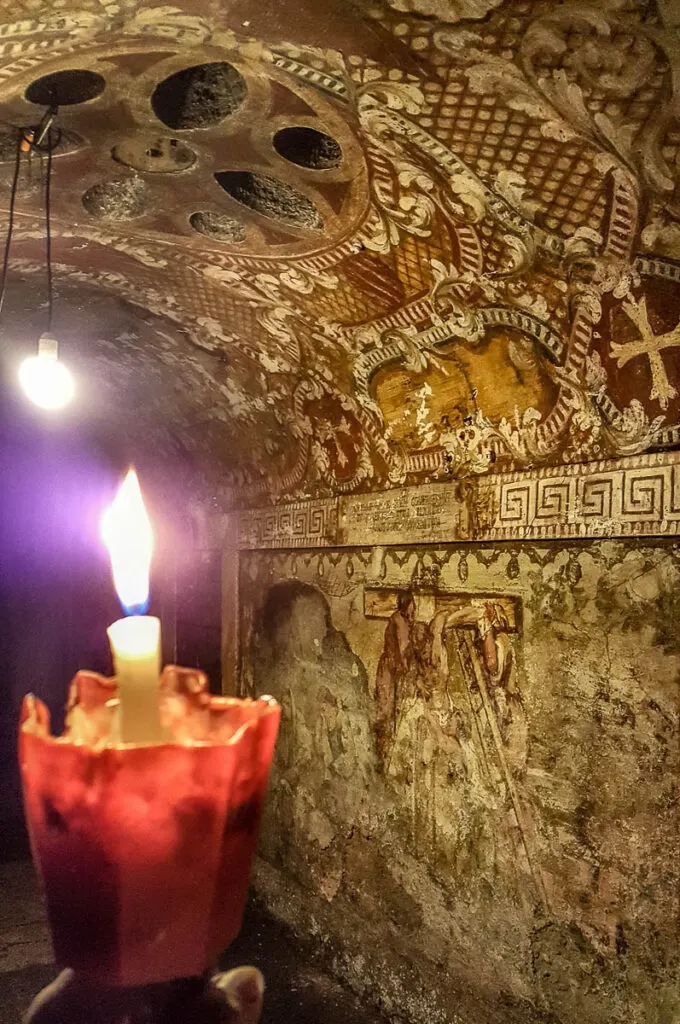
Do you think of Venice as a place of gushy romance?! Think again!
Venice has a myriad of facets and even more secrets. With its:
- curving alleys abruptly ending on the edge of yet another dark canal,
- deep wells in the middle of its many squares,
- dense fogs that envelop the lagoon in their ghostly embrace;
- gothic palaces that after dark make you feel like you are in an eerie dream; and
- confusing labyrinthine character,
this is a city where you can feel the weight of many centuries and where many stories didn’t necessarily have the Hollywood happy ending.
So, when in Venice, make sure that you look beyond its lustre of romance and delve deep into its mysteries and legends. Shine a light on underground crypts, ghostly apparitions, and monstrous creatures. Let this blog post be your guide:
EVENTS IN VENICE
Venice has a wonderful calendar of lively festivals. Many of them have deep roots that go back centuries in time. Others are inspired by the arts and sports. If you can, time your visit to coincide with one of them. This way you will experience the authentic spirit of the City of Canals.
Here is the year in events in Venice:
January – On 6th January, Venice marks Epiphany with a special race – the Regatta of Befana. Befana is an old lady with a broom and a long nose. She brings presents to the well-behaved Italian kids. What do the naughty ones get instead? Find out here.
January/February – Venice celebrates its famous Carnival. Don a mask and be merry.
April to November – Venice Biennale is a behemoth of an event with happenings dedicated to architecture, dance, music, film, and other branches of the arts.
May – attend the Festa della Sensa. This is when Venice celebrates its Marriage to the Sea in an ancient ritual asserting its dominance over the Adriatic. Vogalonga also takes place in May. This is a 30 km paddling/rowing race from Venice across the Venetian Lagoon to the island of Burano.
June – every four years Venice hosts the Regatta of the Ancient Maritime Republics.
July – come to Venice on the third weekend of this summer month for the Festa del Redentore. This is a thanksgiving commemoration of the end of a 16th-century bout of the plague. The festivities include walking on a temporary pontoon bridge across the Giudecca Canal and splendid fireworks that light up the skies above Venice.
September – the first ten days of this summer-meets-autumn month are under the sign of the Venice International Film Festival. The first September weekend is when the Regata Storica takes place. This is a hotly contested boat race opened by a lavish procession on water that recreates Venice’s past glories.
October – come run the Venice Marathon. Alternatively, cheer up the runners.
November – celebrate the Day of St. Martin on the 11th of the month with a large biscuit shaped like the charitable saint on his horse. On 21st November, head to the Basilica della Salute to give thanks for the end of a 17th-century plague epidemic.
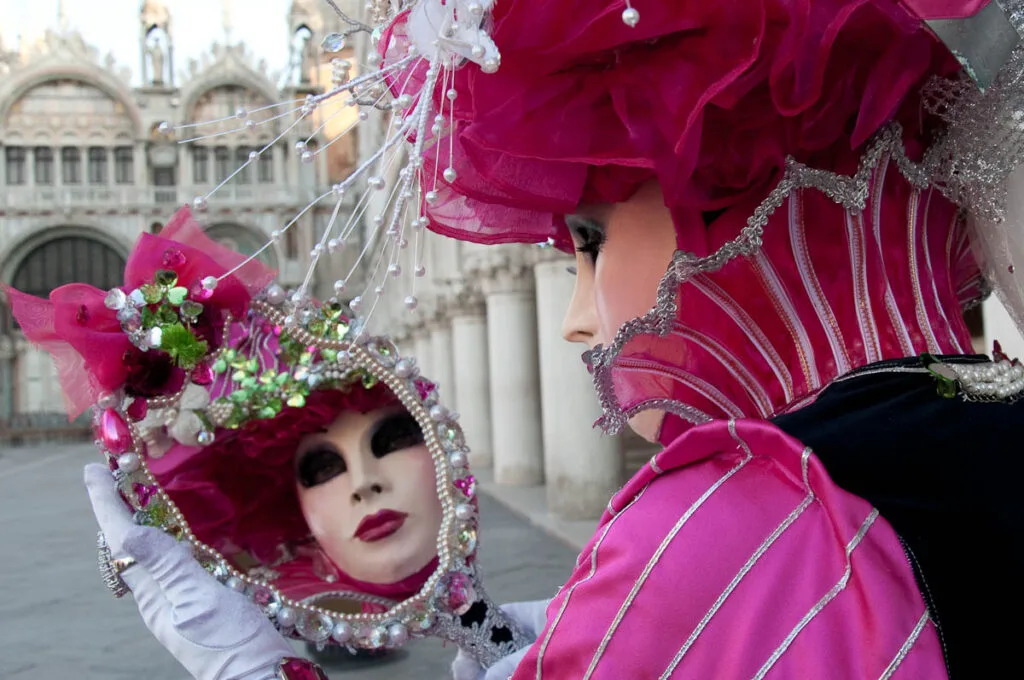
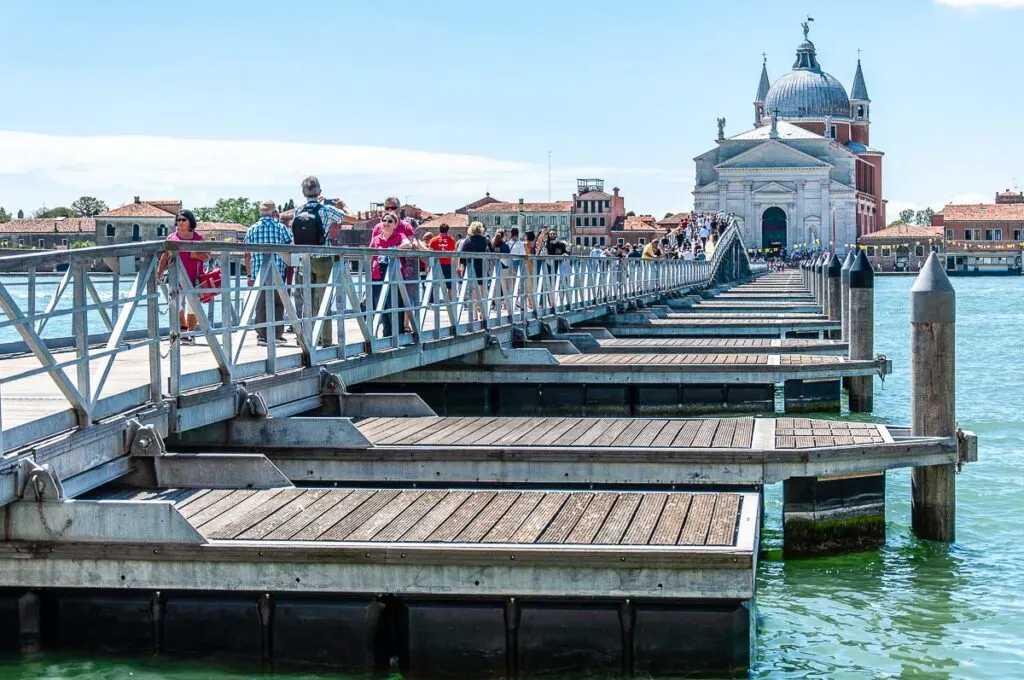
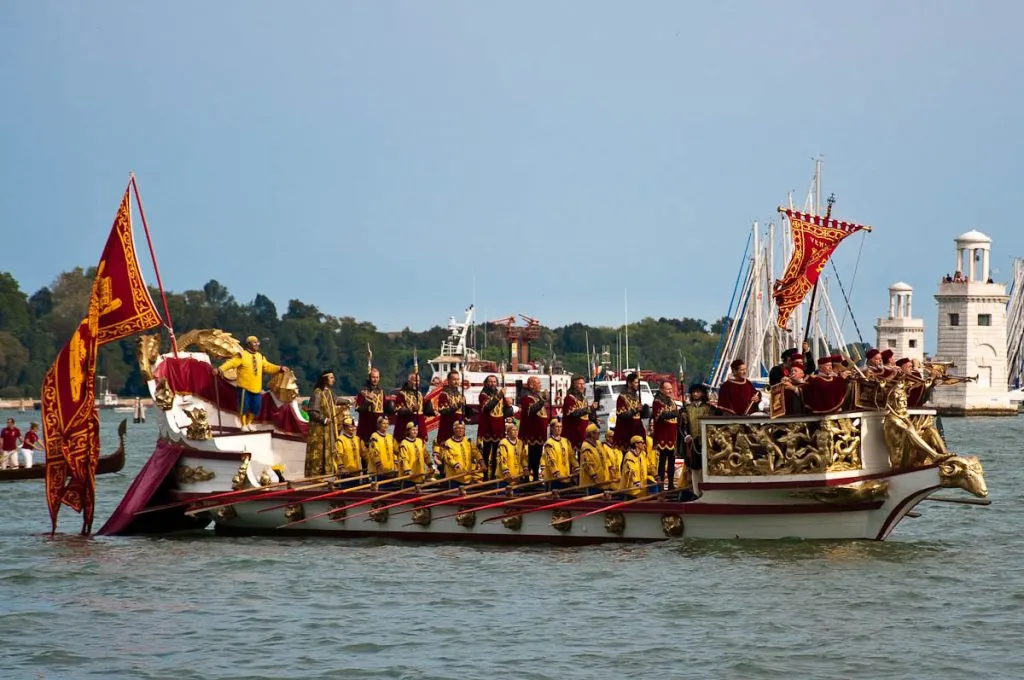
VENICE WITH KIDS

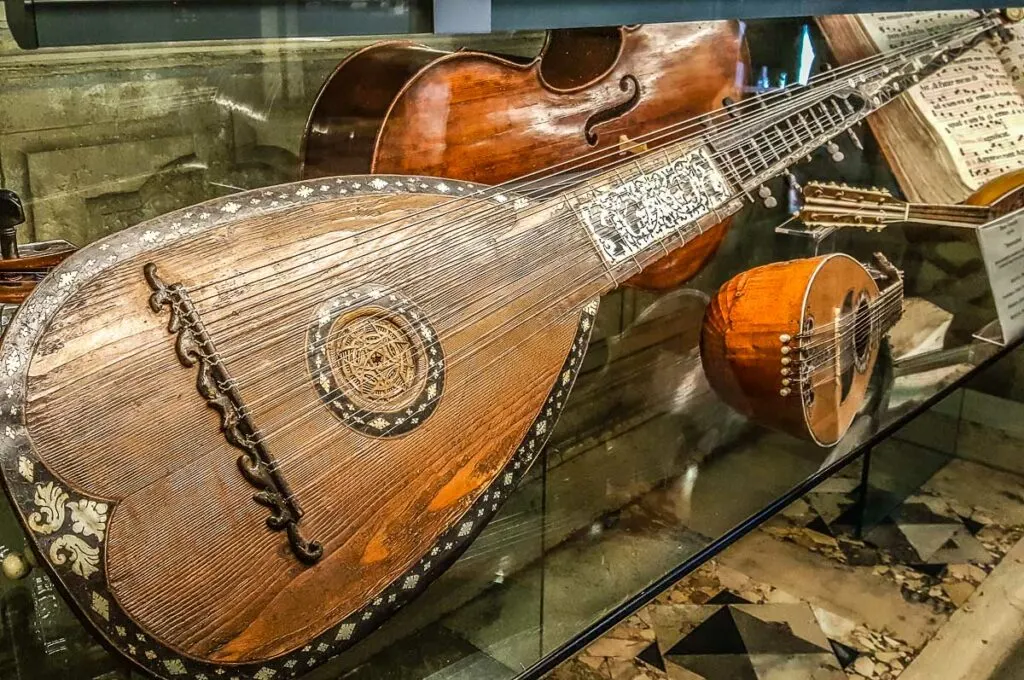
Is Venice a good place to visit with kids? This is a very valid question considering the city’s unusual layout and the immediate access to water. My personal opinion is that Venice is a great place to visit with kids with vivid imaginations and open to learning new things. Also, kids who like to walk around and explore.
You can have a wonderful time in Venice with children. From visits to the city’s museums (the Natural History Museum, the Ship Pavilion, and the free Museum of Music are good starting points) to a gondola ride, a glassmaking demonstration, and the quirky Libreria Acqua Alta, there is always something here to keep you excited and busy.
A vaporetto ride down the Grand Canal or across to an island in the Venetian Lagoon can provide time for relaxation while enjoying splendid views. For more panoramas, climb to the top of St. Mark’s bell tower, the Fondaco dei Tedeschi department store, or the lovely Scala Contarini del Bovolo.
Charm your kids with stories about Venice (or book a licensed tour guide to do it). Get them to walk around the city trying to spot as many winged lions on facades or weird and wonderful boats in the water. Entice them with unusual local foods and pop into every gelato shop that you walk past.
MY BLOG POSTS ABOUT VENICE
- Rialto Bridge – 15 Fascinating Facts About the Most Famous Bridge in Venice, Italy (With Maps, Travel Info, and Practical Tips)
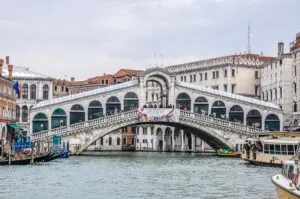
- Dorsoduro, Venice – How to Visit and Best Things to Do in the Most Underrated Corner of Italy’s City of Canals (With Maps, One-Day Itinerary, and Practical Tips)
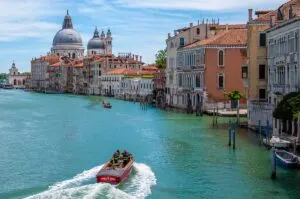
- 60 Things to Do in Venice You’ll Love – The Ultimate Venice To-Do List (With Map and Practical Tips)
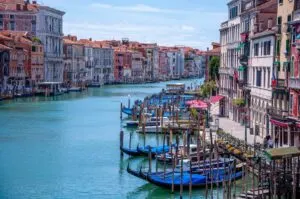
BEST TOURS TO TAKE IN VENICE
Booking a tour of Venice with a reputed tour guide or travel company is a shortcut to getting to know intimately this unique, beautiful, and often overwhelming city. It equals stepping through a secret door to discover all of the best corners of Venice and the Venetian Lagoon which otherwise may be difficult to come across one by one on your own.
With a millennial history, a rich catalogue of art, and many traditional crafts with outstanding output, Venice in Italy is a delight to visit. It’s a city with canals instead of roads and boats instead of cars. It keeps many secrets that it reveals to only those in the know. No matter how many books or guidebooks you may read about Venice before coming here, the City of Canals can still be a shock to the system. You may find yourself traversing its narrow curving lanes unsure where to head to first and what to delve into next.
It is at this point that an expert local guide or a reputable tour company can be of great help. With a structured approach and offering tours covering specific fields of knowledge or tailored to your personal interests, you can see and experience the maximum of Venice within the shortest amount of time.
Have a look at this blog post to start your research of tours in Venice:
Alternatively, select directly local tours and activities in Venice on GetYourGuide, Viator, and Tiqets.
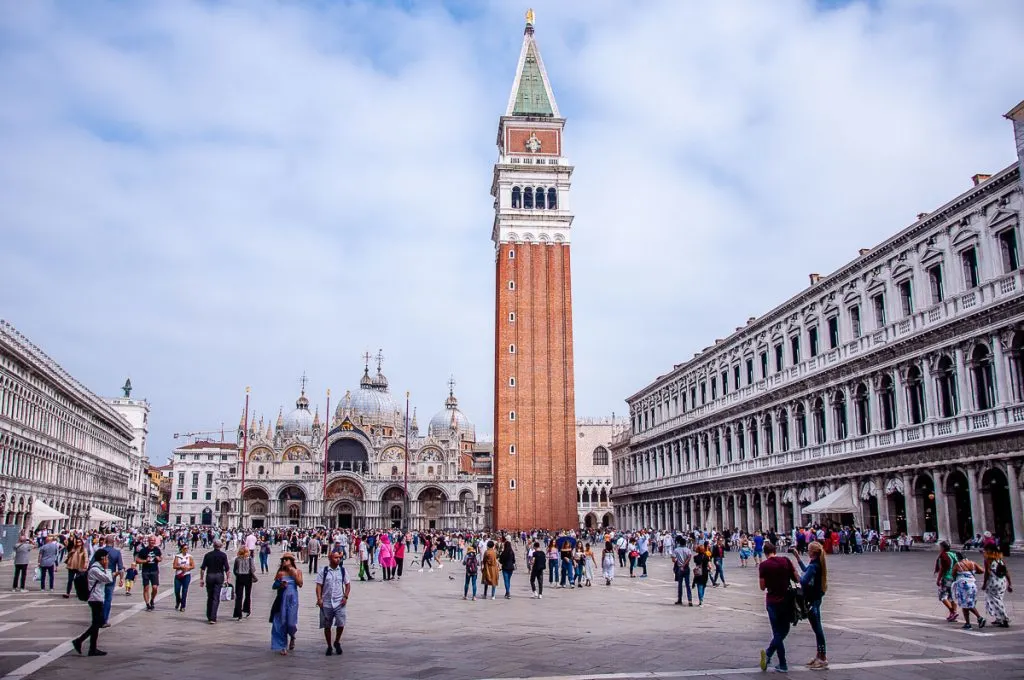
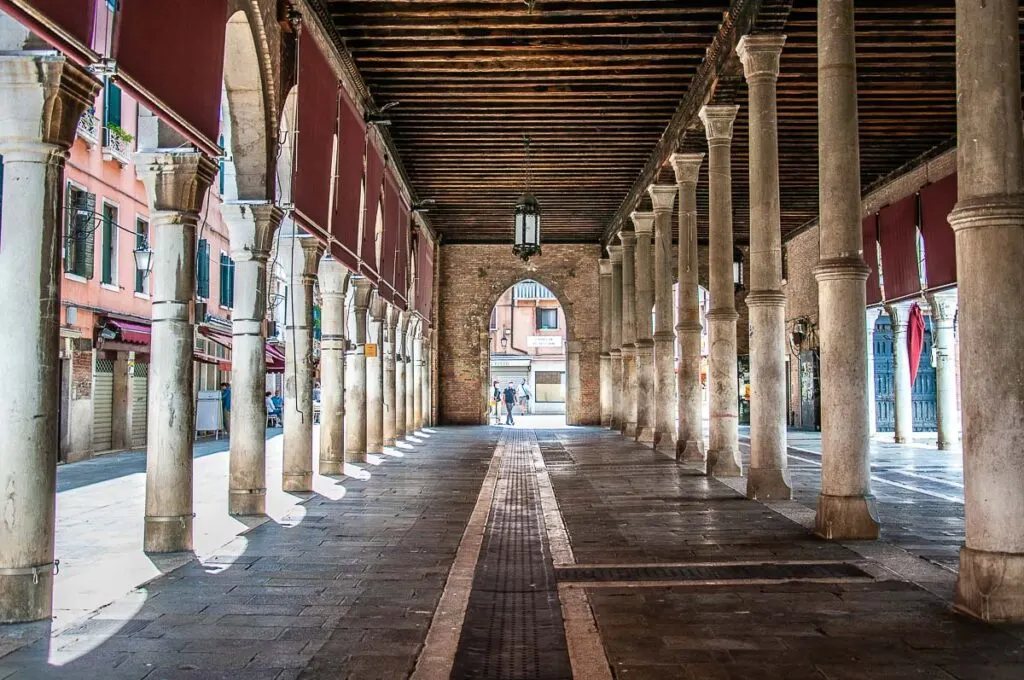
ISLANDS TO VISIT IN THE VENETIAN LAGOON
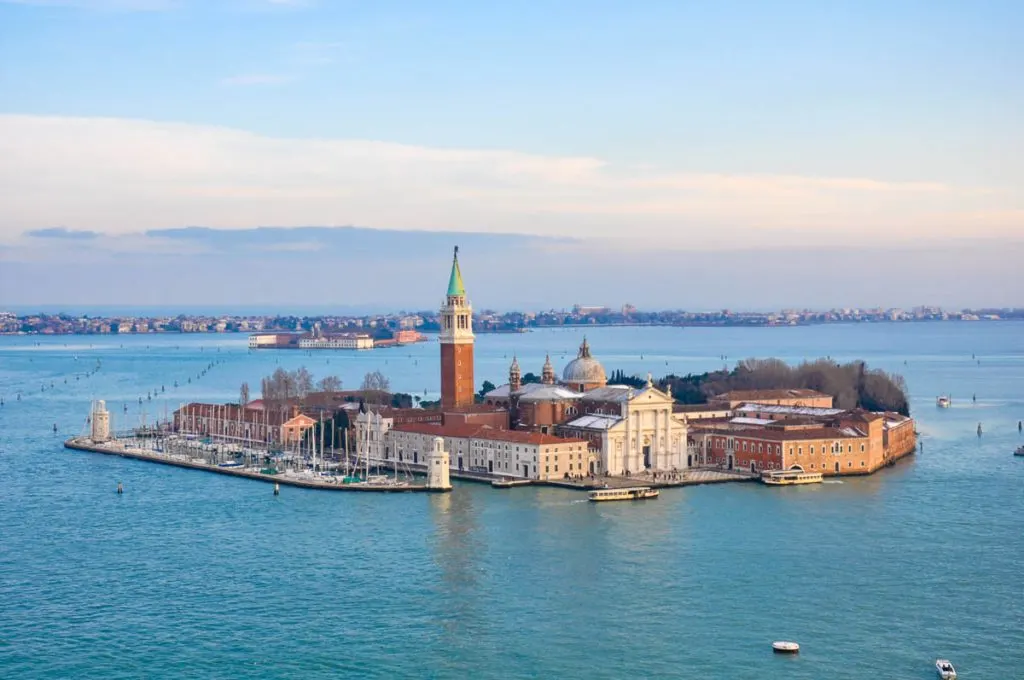
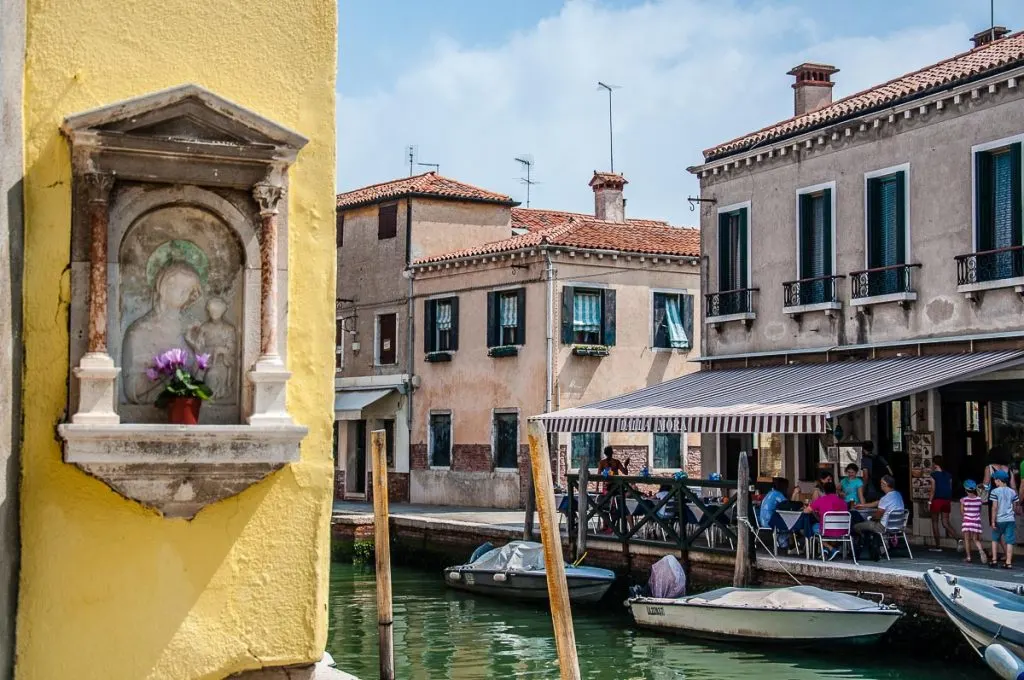
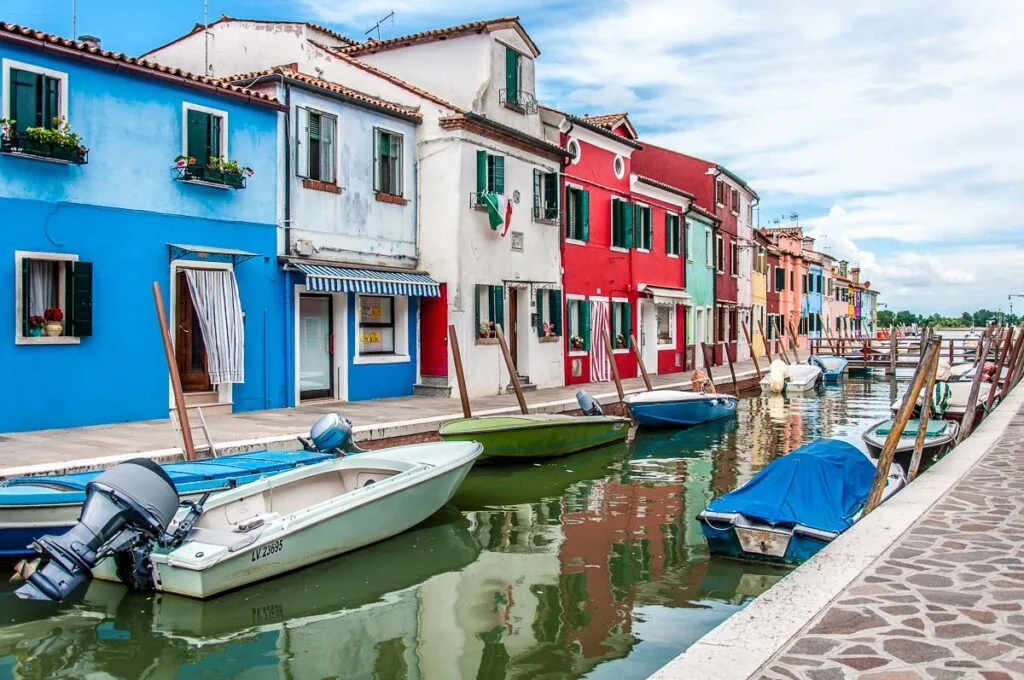
Venice is built on 118 small islands in the heart of the Venetian Lagoon. Yet a short trip by boat away from the main historic part of Venice, you will find several other Venetian islands worth a visit. Each one of them has something that makes it unique. You can either spend a day in one or combine two or three for a day trip to remember.
Here are three of the best islands to visit in the Venetian Lagoon:
- San Giorgio Maggiore – this tiny island features as a backdrop in many iconic photos of Venice. Its main draw is the huge church designed by the renowned Renaissance architect Andrea Palladio. Its bell tower reveals beautiful panoramic views of the Doge’s Palace and the City of Canals.
- Murano – famous for its centuries-old traditions of glassmaking. A walk around the island must include a visit to at least one of the many glassmaking workshops here. There is also an outstanding Glass Museum and one of the oldest buildings in the Venetian Lagoon – the Church of Santi Maria e Donato – which also has beautiful floor mosaics.
- Burano – famous all over the world on account of its colourful houses. Each one is painted in a different bright hue. Together, they create a stunningly vibrant effect. Crisscrossed by canals and dotted with restaurants serving the traditional risotto di go, the island is the perfect place for a leisurely walk and a long lunch. Make sure that you taste Burano’s famous cookies – esse and bussolà (also sometimes called buranelli). Don’t skip the local Lace Museum to learn about the island’s traditional craft of lacemaking.
There are many other islands to explore in the Venetian Lagoon. From Giudecca and Lido di Venezia to Sant’Erasmo and Torcello, each Venetian island has its own character and stories to tell.
You can spend a wonderful half a day or a full day crisscrossing by boat the Venetian Lagoon and visiting its islands. For this, you can book a guided tour in advance or simply rely on the local network of vaporetti.
BEST DAY TRIPS FROM VENICE
From history and art to a unique natural setting, Venice has a lot to offer in many different ways. One of the best things about Italy’s City of Canals is its proximity to several must-see large Italian cities, beautiful medieval towns, and picturesque villages.
Worldwide famous destinations such as Verona, Bologna, and Lake Garda and cute hidden corners such as Borghetto sul Mincio, Bassano del Grappa, and the Euganean Hills are easy to get to from Venice offering numerous opportunities for great day trips. Cities of Art such as Padua, Vicenza, and Ferrara expand the list infinitely.
If you are spending more than three days in Venice, then put aside half a day or a full day for an exciting day trip to the Italian mainland. The following blog posts will give you many ideas to consider as well as travel information from Venice to specific must-see destinations in Italy:
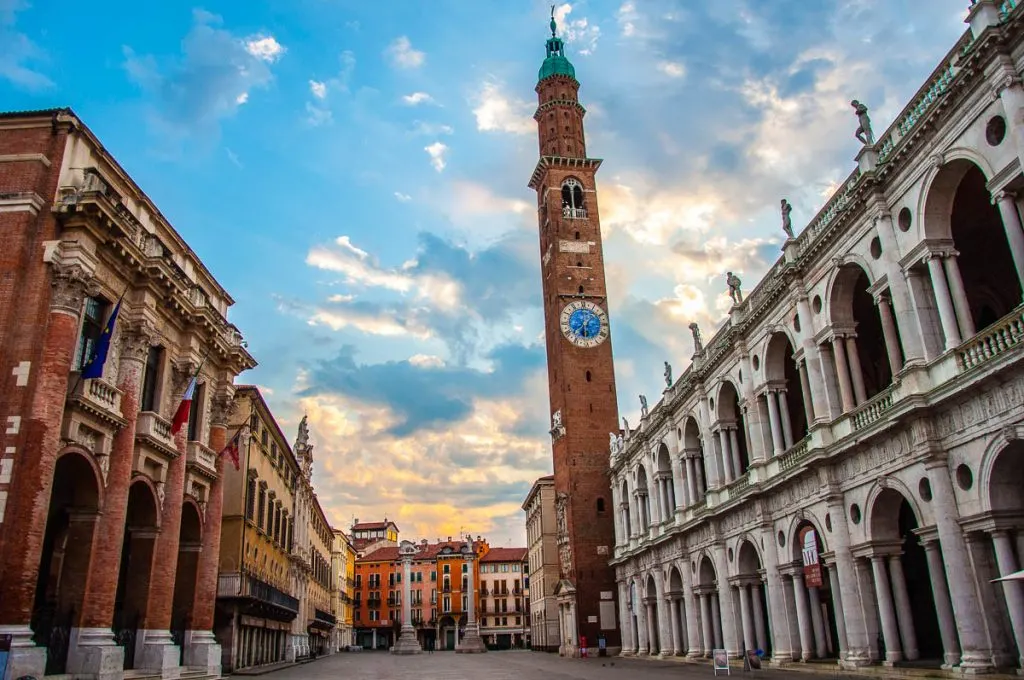

BEST BEACHES NEAR VENICE
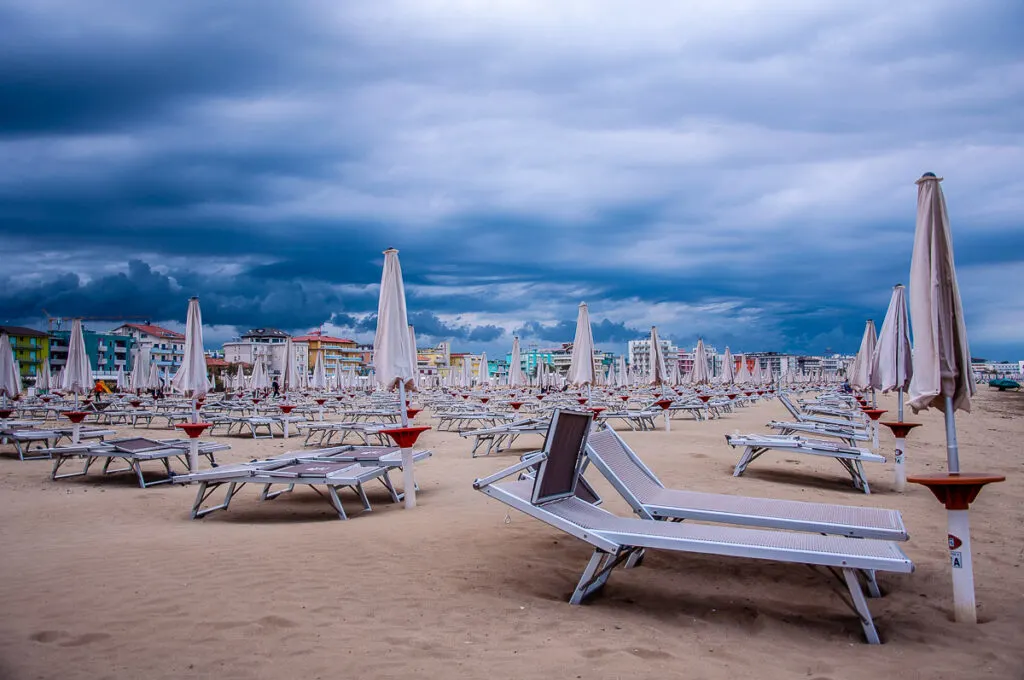
While Venice itself is not strictly a beach destination, you will find some of the best beaches in Italy right next door to it. Take the vaporetto – the Venetian water bus – from the iconic St. Mark’s Square for the short trip across to Lido di Venezia. This long thin island serves as a barrier between the Venetian Lagoon and the Adriatic Sea and it’s dotted with gorgeous beaches.
Long sandy strips stretch along the Adriatic coast both up north and down south from Venice. An easy trip away by car, bus, or train and you can top your tan at such fabulous summer resorts as Sottomarina, Cavallino Tre Porti, Lido di Jesolo, and Caorle.
In summer, a day at the beach is a great way to relax after a session of strenuous sightseeing in Venice. Find more details in this blog post:
BEST TRAVEL GUIDES FOR VENICE
WHAT TO BUY FOR VENICE
WHAT TO BUY IN VENICE
If you love shopping, in Venice you will be spoilt for choice. From high-fashion boutiques and quirky antiquarian shops to the workshops of local artisans, the selection of high-quality items to invest in is huge.
There are also lots of shops and stalls selling cheap souvenirs mass-produced abroad. So, it pays to learn a bit about the traditions behind authentic Venetian crafts and to shop only from respectable artisans. Here are some unique things to buy in Venice and some of the best local makers to purchase them from:
Venetian masks from Ca’ Macana
Murano glass from one of the companies members of the Consorzio Promovetro Murano. Only purchase Murano glass items that have the trademark Vetro Artistico Murano. It guarantees that the items were made on the island of Murano in compliance with the existing laws.
Venetian marionettes by L’Isola di Pinocchio
Handmade beaded jewellery by Venetian Dreams by Marissa Convento
Acqua di Melissa (lemon-balm water) from the monastic shop of the Order of the Discalced Carmelites
Silk velvet bags and accessories by Tessitura Luigi Bevilacqua
Prints and paintings by Plum Plum Creations
Marbled paper and leather-bound books and accessories by Paolo Olbi
Wooden puzzles and toys by Signor Blum
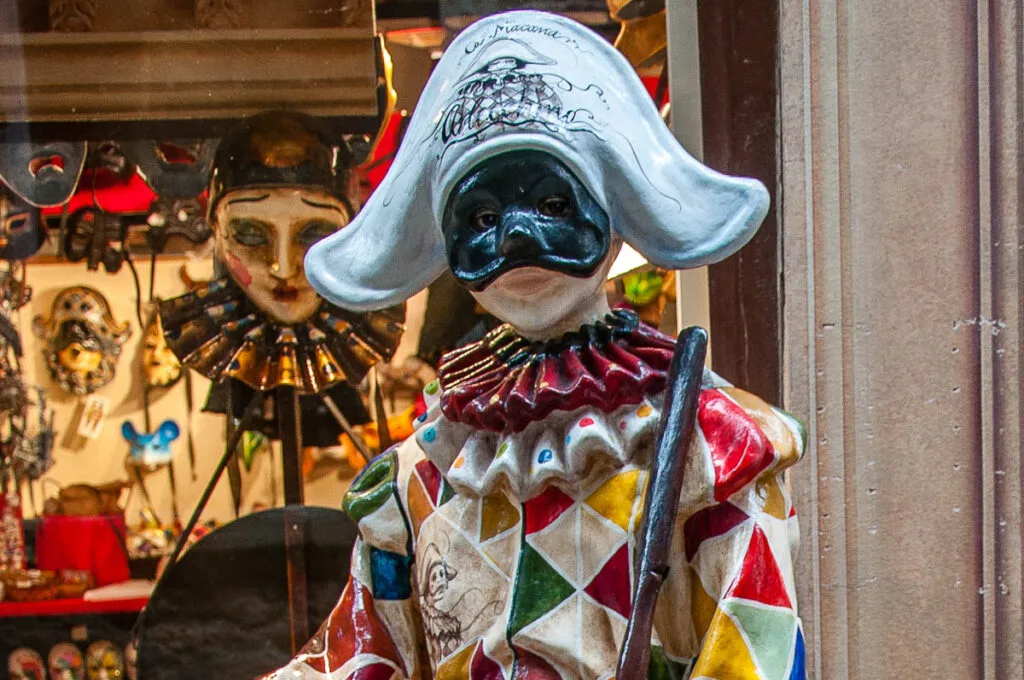
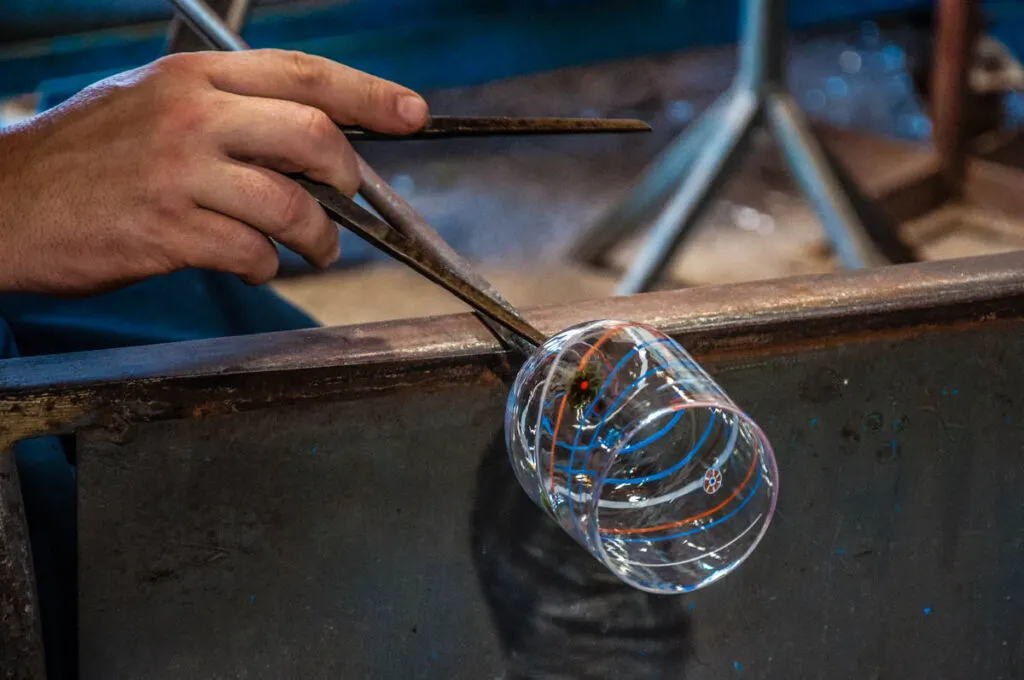
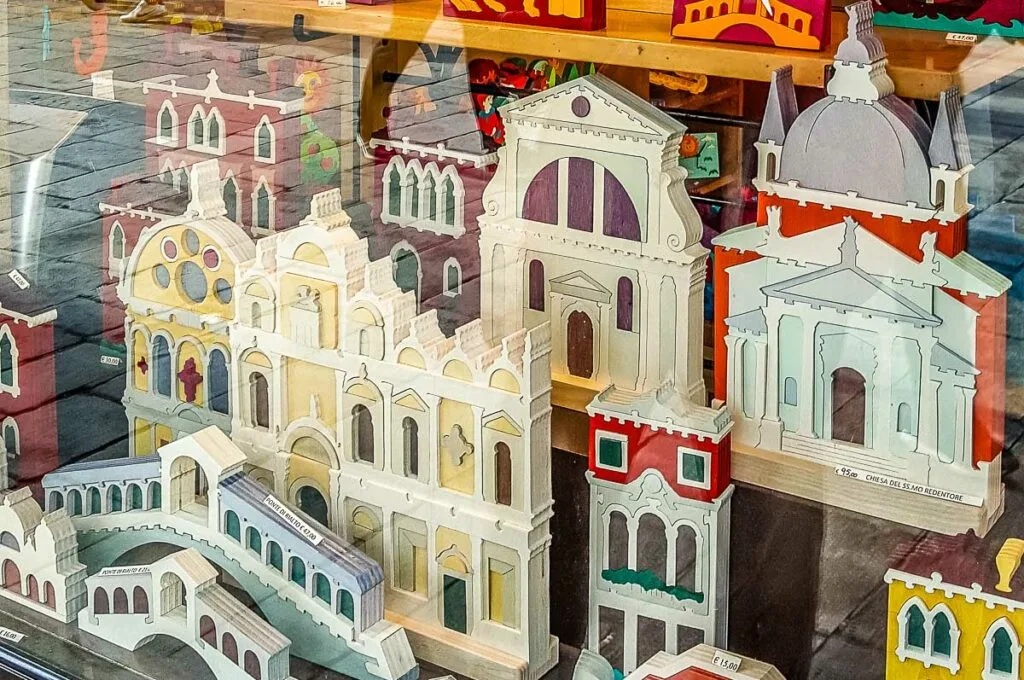
BEST BOOKS ABOUT VENICE
MORE INFORMATION ABOUT VENICE
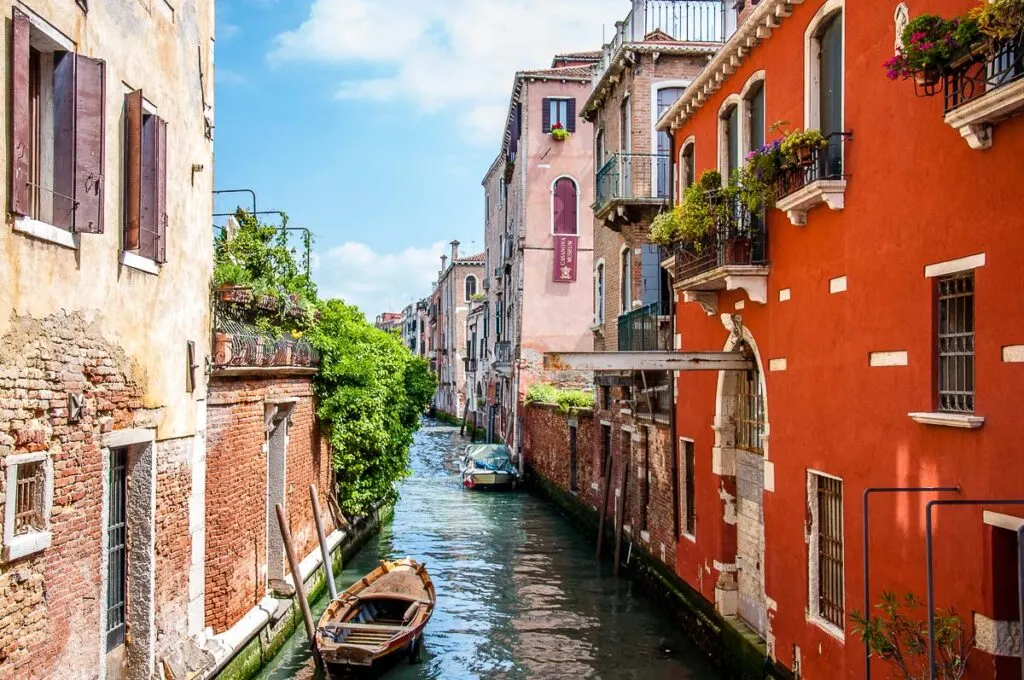
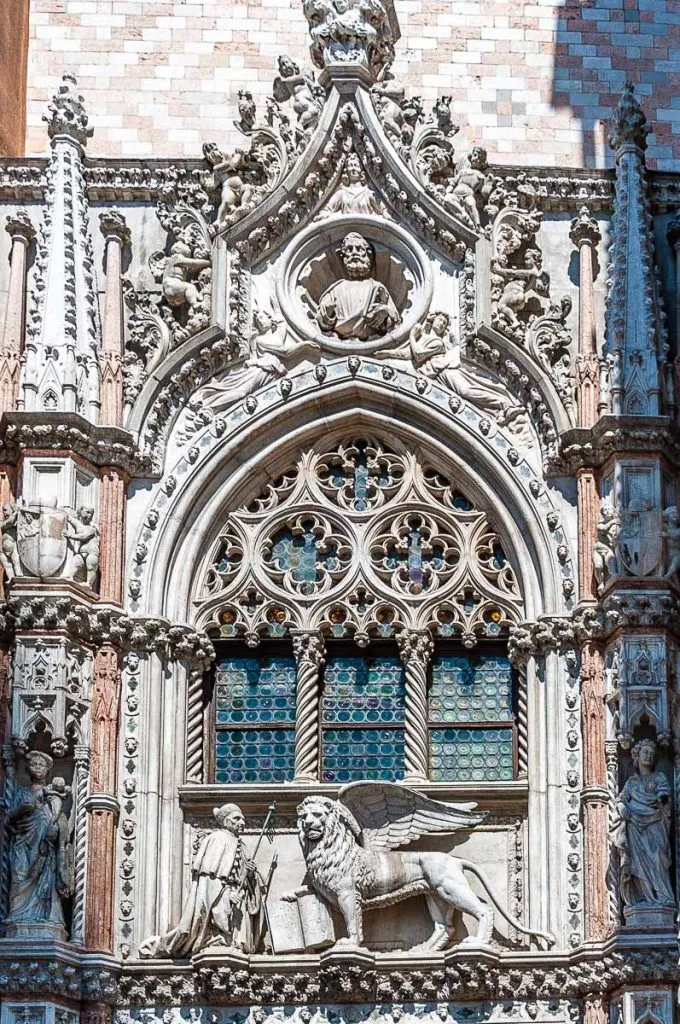
Venice is a very popular topic to write about. A simple Google search will return millions of results providing you with information about travelling to and exploring the City of Canals.
In addition, many books have been written about Venice. They delve into its millennial history, explain in detail the practicalities of visiting it or use it as a marvellous stage for romance and tragedies.
It’s not very humble of me to say it but if you are looking for detailed, well-researched, and first-hand tried and tested information about Venice, have a look at my relevant blog posts.
I have been visiting Venice for close to twenty years now and writing about it for close to ten years. On the pages of this blog, I have shared lots of useful information. I hope that it will come in very handy during the preparatory stages of your Venetian holiday.
Here are the relevant links:
Venice: Essential Tips, Things to Do, Major Landmarks, Hidden Gems, How to Navigate Venice, Venice in a Day for Art Lovers, Train Stations, Nearest Airports, Best Tours, Beaches of Venice, Quotes about Venice, Boats in Venice, Haunted Venice, Day Trips from Venice, Arco del Paradiso
Travel to and from Venice: Treviso to Venice, Verona to Venice, Florence to Venice, Milan to Venice, Bologna to Venice, Venice to Lake Garda, Venice to Padua, Venice to Verona, Venice to Milan
Venice Videos: Grand Canal, St. Mark’s Square at Carnival, St. Mark’s Square, View from Rialto Bridge, View from Accademia Bridge, Venetian gondolas, Historical Regatta, Squero di San Trovaso, Palazzo Contarini del Bovolo, Fondazione Querini Stampalia, Palazzo Grimani, Rialto Fish Market, Ca’ Macana, Festa della Madonna della Salute
Finally, have a look at my Amazon Shop. I have a special section with all the best books about Venice in terms of history, travel, art, and fiction writing. There is a lot to read and a lot of exciting information to uncover about the City of Canals.
MORE INFORMATION ABOUT ITALY
I have been blogging about travelling to and within Italy for close to ten years now providing detailed and first-hand tried and tested information about the best things to do in this beautiful country. It’s all based on my close to twenty years of visiting Italy solo and with my family. Six of them, we actually spent living in Vicenza in the north of the country.
If you are after in-depth researched and illustrated with dozens of original photos articles about Italy, have a look at the following categories and blog posts:
- Italy – a full list of all my blog posts about Italy
- 10 Reasons to Visit Northern Italy
- Veneto, Trentino, Emilia Romagna, Umbria – full lists of all my blog posts about these Italian regions
- Venice, Padua, Lake Garda, Lake Como, Milan – full lists of all my blog posts about these must-see destinations in Italy.
In addition, right at the end of this page, you will find a list with links to some of my most popular blog posts about many beautiful and exciting cities, towns, and regions to visit in Italy. So, just scroll down and then click on the ones you want to know more about.
Finally, Italy’s official tourism website is a great source of the latest news about travel in Italy. Otherwise, this is one of the best guidebooks about Italy.
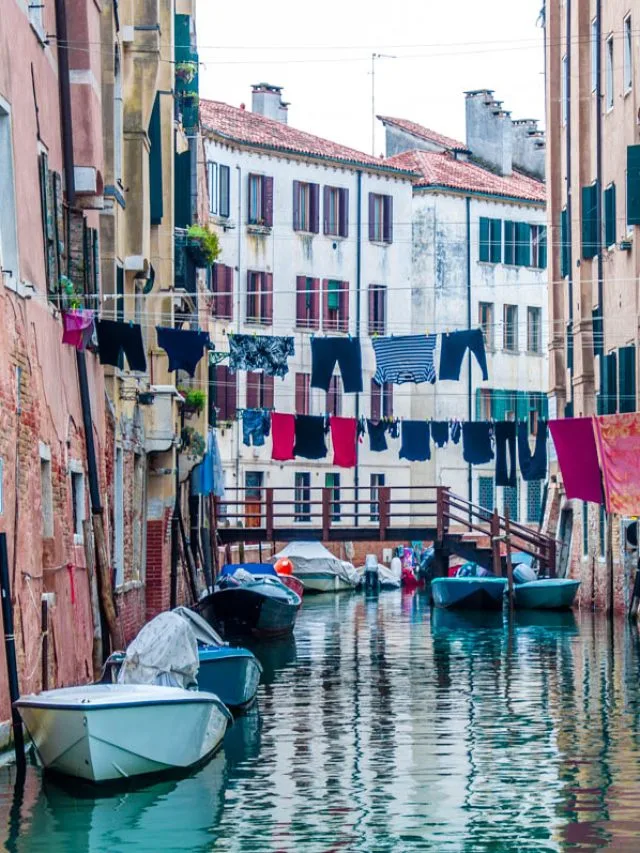
MY TOP 5 TIPS FOR VENICE
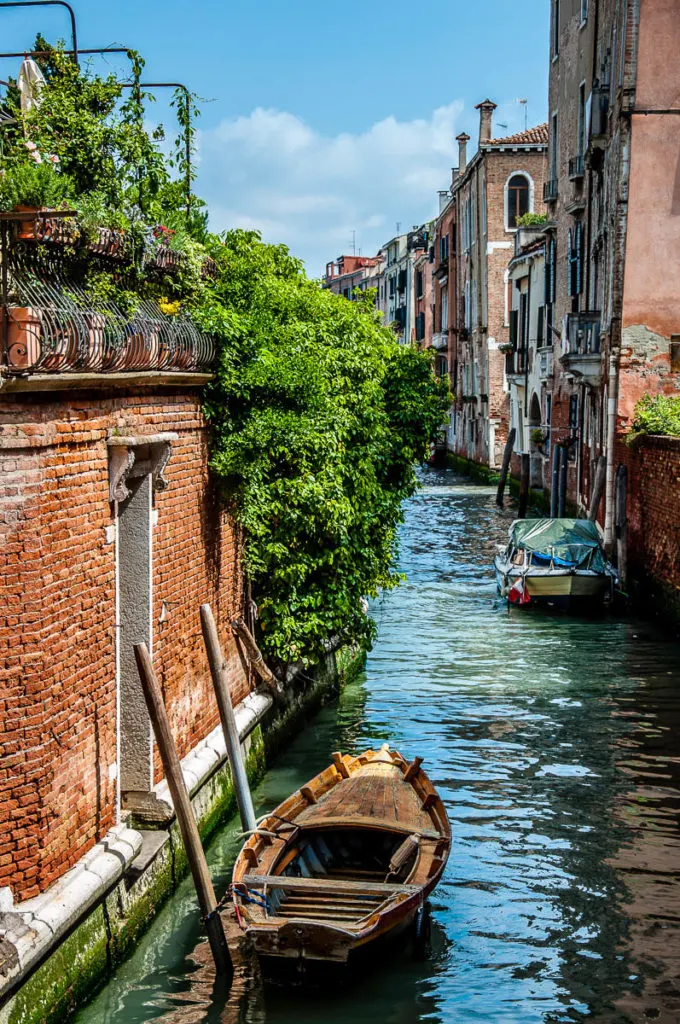
- In Venice, walk on the right. With narrow curving streets – many of which are used by thousands of people every day – keeping to the right ensures that the pedestrian flow is as fast and smooth as possible.
- Where possible, book entry tickets in advance. This will minimise waiting times and will allow you to make the most of your day. This is a great resource for tickets for Italy’s best museums and landmarks.
- Have lots of traditional Venetian food. From cicchetti and baccala’ mantecato to Carnival frittelle and traditional pastries, Venice has its own cuisine that has developed over many centuries.
- Get off the beaten path. Venice is rich in hidden gems. Getting to know them one by one will enrich your understanding of and deepen your love for the City of Canals.
- To see the authentic Venice, wake up early and go to bed late. Free of tourist crowds, Venice is incredibly peaceful and cinematic and you will discover a whole new face to it.
Learn More:
5 THINGS NOT TO DO IN VENICE
- Don’t swim in the Venetian canals. Boat traffic is heavy here and the quality of the water is unfit for bathing.
- Don’t arrive unprepared. Venice is a multilayered city with a millennial history. Having a plan in advance for the things you want to do and see here will help you experience the City of Canals in a more complete and satisfying way.
- Don’t buy fake Venetian souvenirs. From Venetian glass and Venetian masks to marbled paper, velvet bags, and handmade lace, invest in high-quality traditional Venetian items. The local artisans preserve the centuries-old secrets of Venice’s crafts and their hard work deserves respect.
- Don’t buy water in plastic bottles. Instead, fill up your water bottle from one of the dozens of free water fountains dotted around the City of Canals.
- Don’t obstruct the bridges. They are Venice’s communication links. Lingering on a bridge – for example, to pose for endless photos – is frowned upon by the Venetians and can actually incur a heavy fine. In this vein, don’t picnic on the squares and streets of Venice. This is considered highly disrespectful and again, incurs heavy fines.
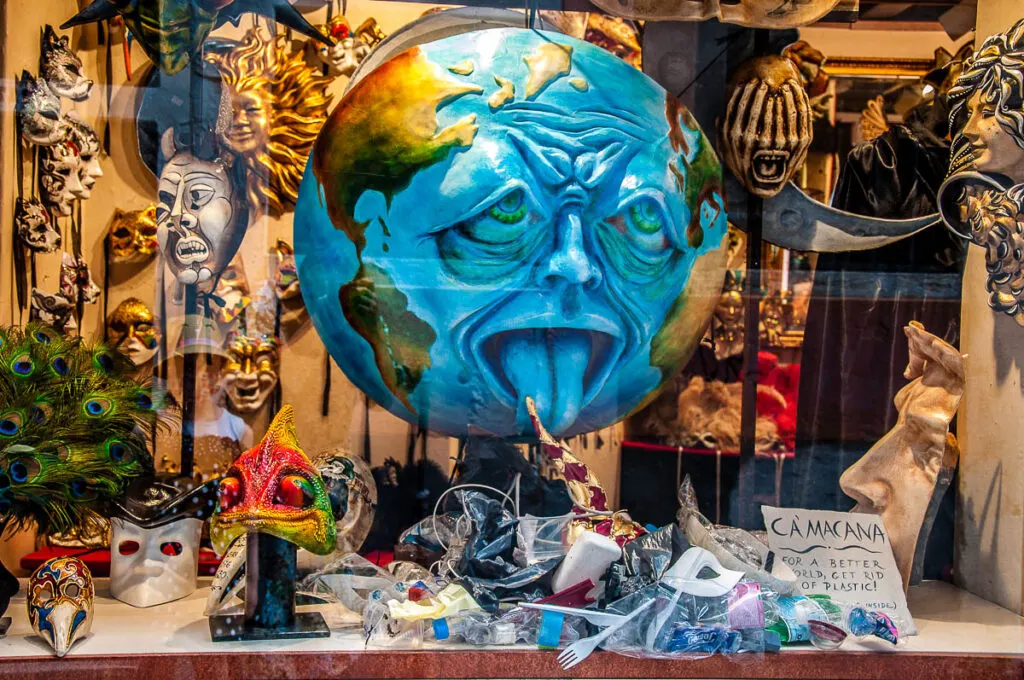
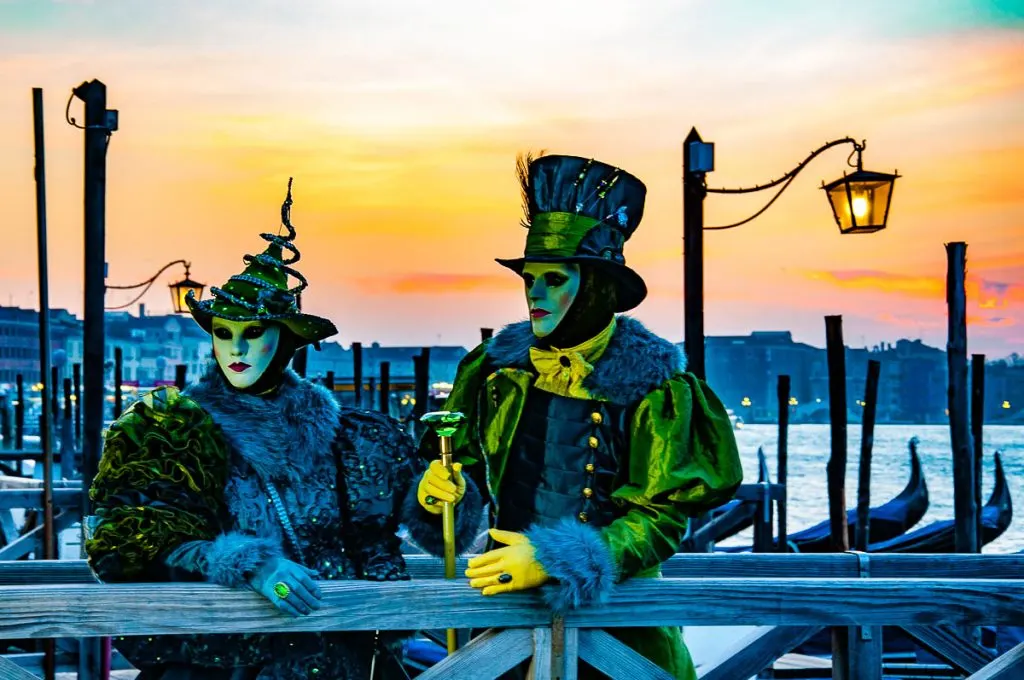
THANK YOU FOR READING
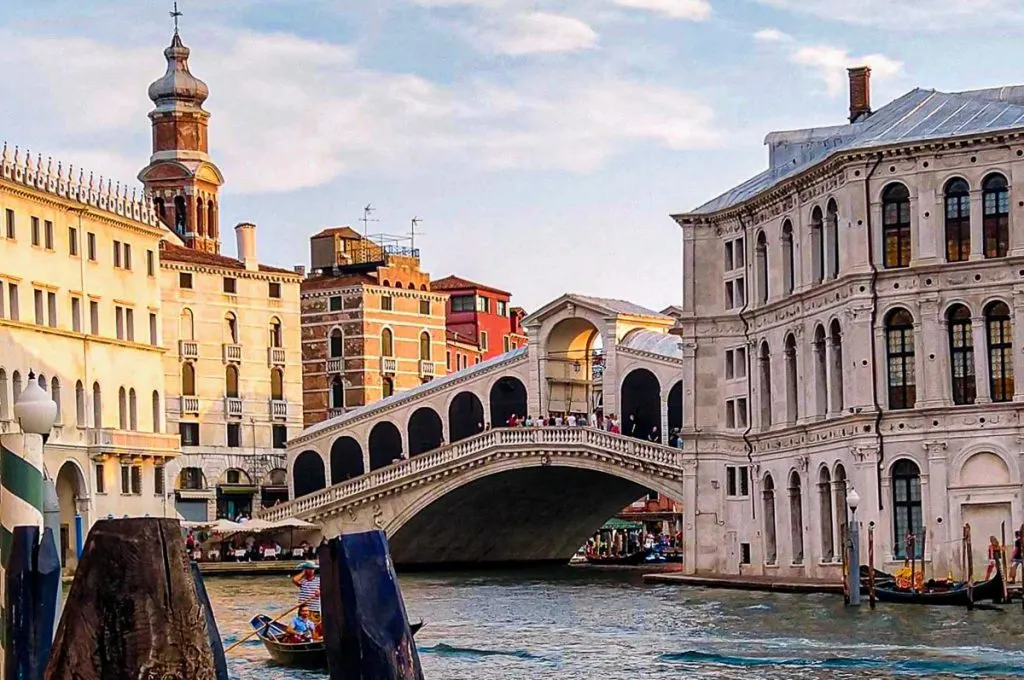
TRAVEL TOOLS
Get Ready for Your Trip to Venice in Italy
Get a guidebook from Amazon.
Buy plane tickets, train tickets, and bus tickets through Omio.
Rent a car from Europcar.
Research accommodation on Booking.com.
Select local tours and activities on GetYourGuide, Viator, and Tiqets.
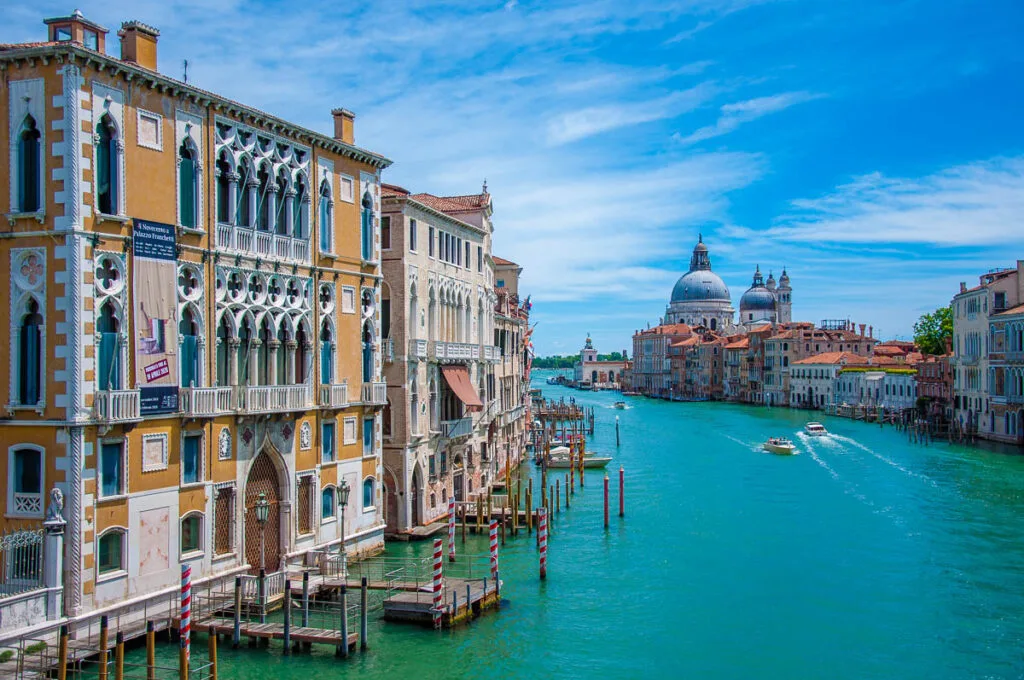
MORE HELPFUL INFO ABOUT ITALY FOR YOU
Best of Italy: Italian Piazzas, Italian Markets, Accommodation for Every Budget, Best Times to Visit Italy, Italy in Summer, Italy with Kids
Italian Food: Best Italian Food Gifts, Cheap Italian Food, Rules of Italian Breakfast, Italian Breakfast Foods
Italian Coffee: Italian Coffee Culture, Italian Coffee Drinks, History of Coffee in Italy
Christmas in Italy: Fun Facts, Things to Do, Italian Nativity Scenes, Panettone, Christmas Guide
Northern Italy: Best Cities to Visit, Major Airports, Reasons to Visit
Lake Como: Ultimate Travel Guide, Best Towns, Best Things to Do, How to Get to Lake Como, Milan to Lake Como, Best Airports, Photos of Lake Como
Lake Garda Towns and Villages: Best Towns, Desenzano del Garda, Lazise, Riva del Garda, Malcesine, Torri del Benaco, Punta di San Vigilio, Campo di Brenzone, Borghetto and Valeggio sul Mincio
Visiting Lake Garda: Map of Lake Garda, Getting Around Lake Garda, Lake Garda with Kids, 8 Best Airports, Venice to Lake Garda, Verona to Lake Garda, Milan to Lake Garda, Bologna to Lake Garda
Verona: Things to Do in One Day, Verona Opera Festival, Day Trips from Verona, Romeo and Juliet Itinerary, Verona to Venice, Verona to Milan
Padua: Things to Do in One Day, 101 Facts About Padua, 10 Reasons to Visit Padua, Day Trips from Padua
Vicenza: Things to Do, Day Trips from Vicenza, Best Museums, The Beauty of Vicenza
Veneto: Top Places to Visit, Unique Adventures, Most Colourful Places, Mysterious Places, Most Beautiful Lakes, Reasons to Visit, Main Cities, Prettiest Small Towns, Most Beautiful Villages
Lombardy: Best Cities and Towns, Reasons to Visit, Brescia
Friuli Venezia Giulia: Venzone, Most Beautiful Villages
Emilia Romagna: Bologna, Ravenna, Comacchio, Most Beautiful Villages
Marche: Reasons to Visit, Gradara, Frasassi Caves, Temple of Valadier
Umbria: Reasons to Visit Perugia

